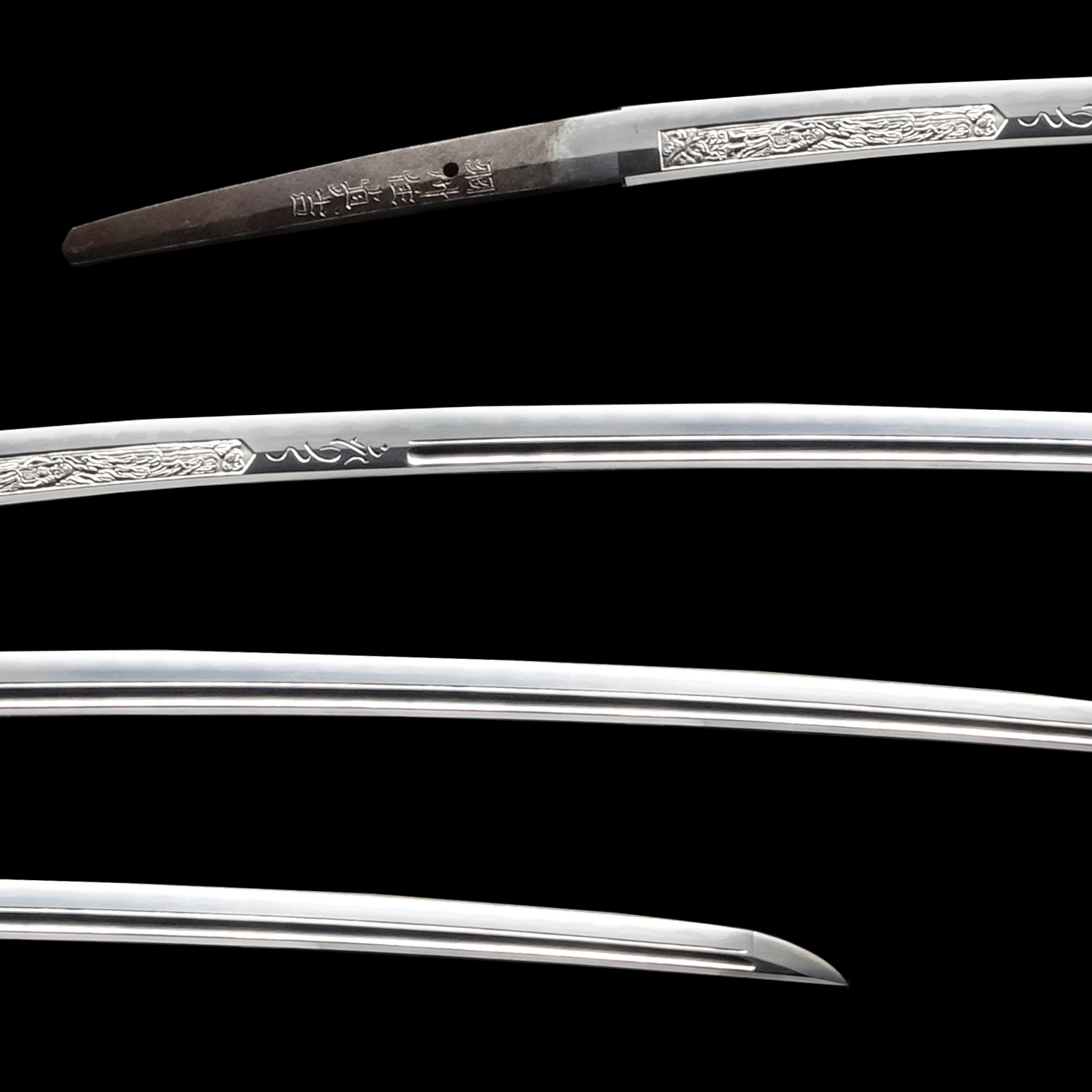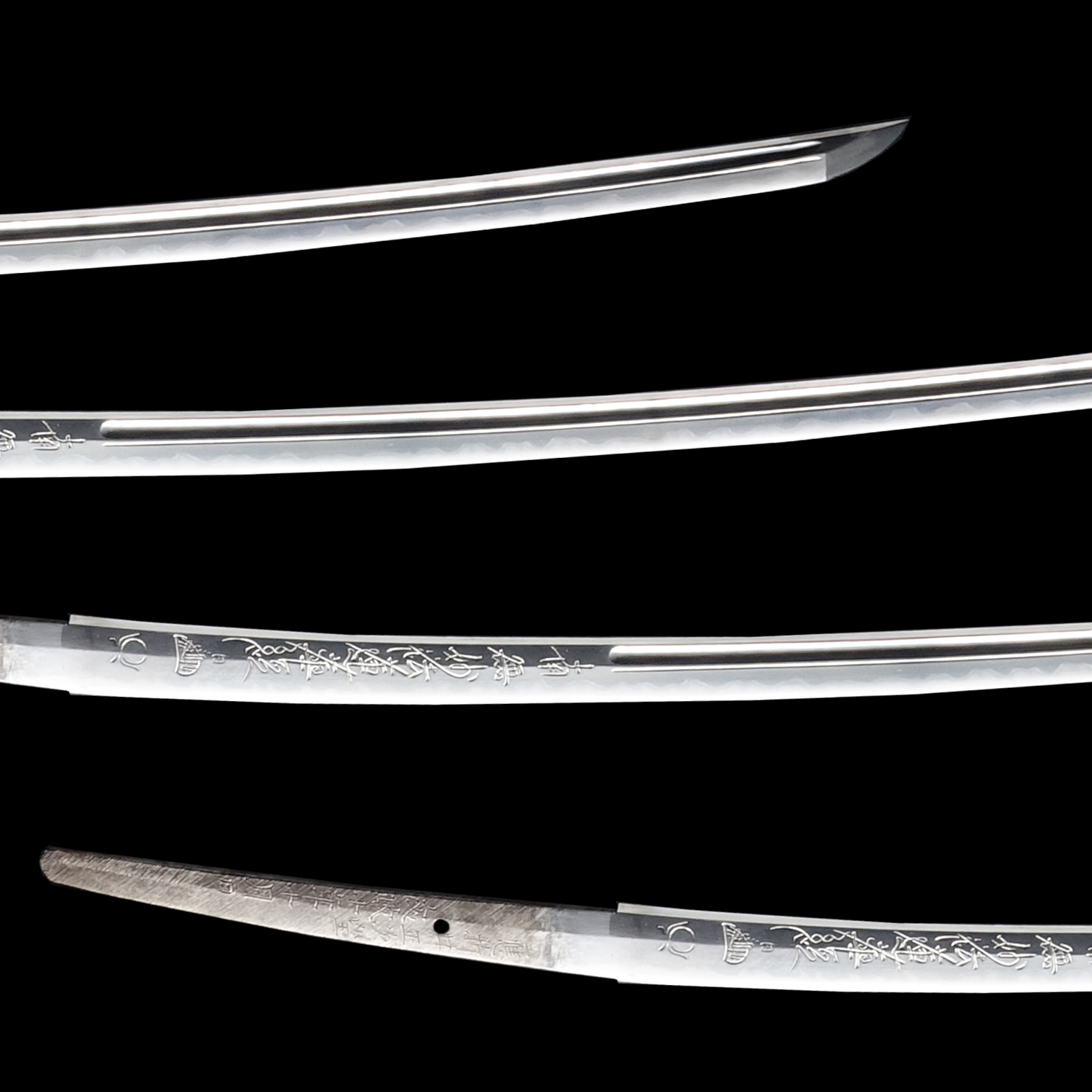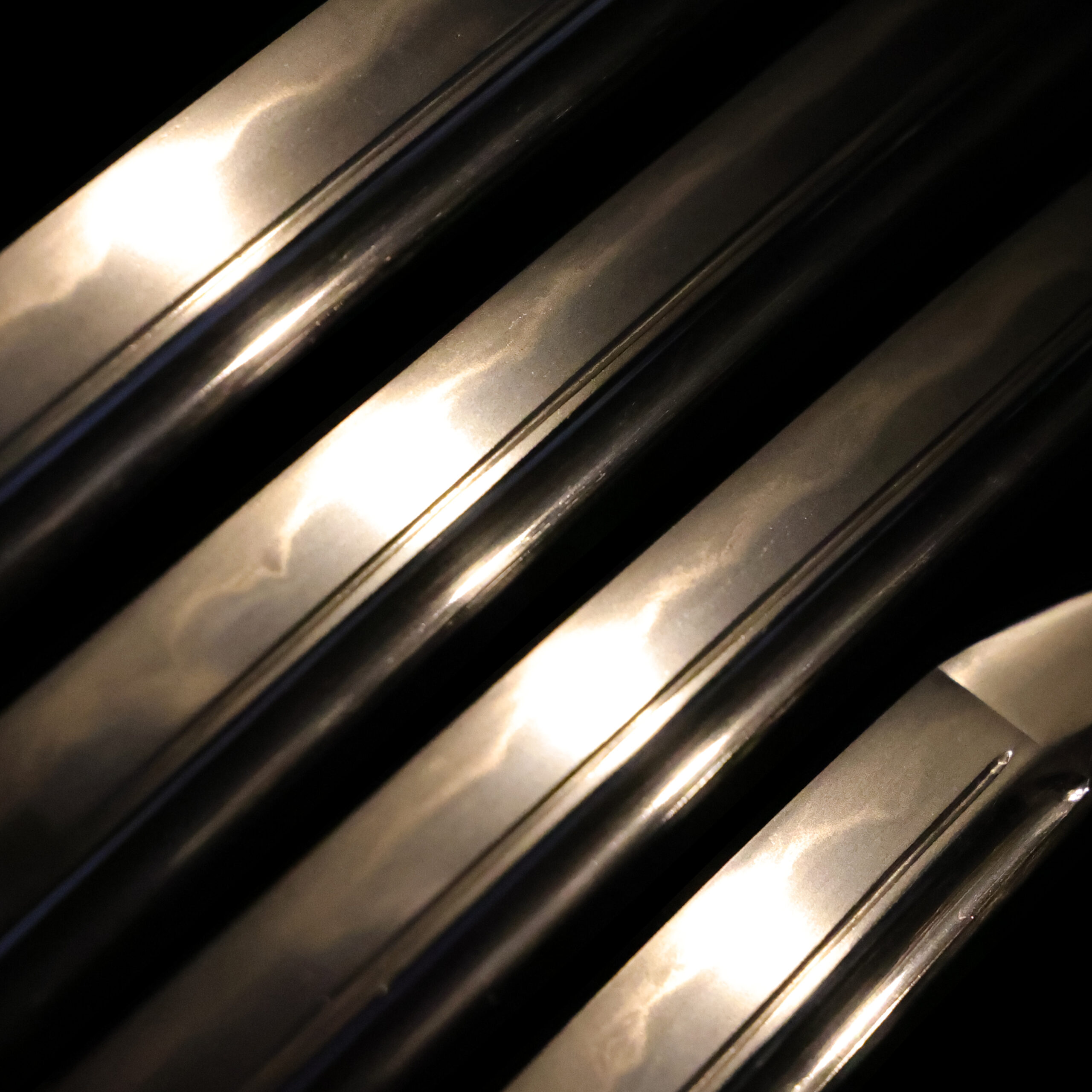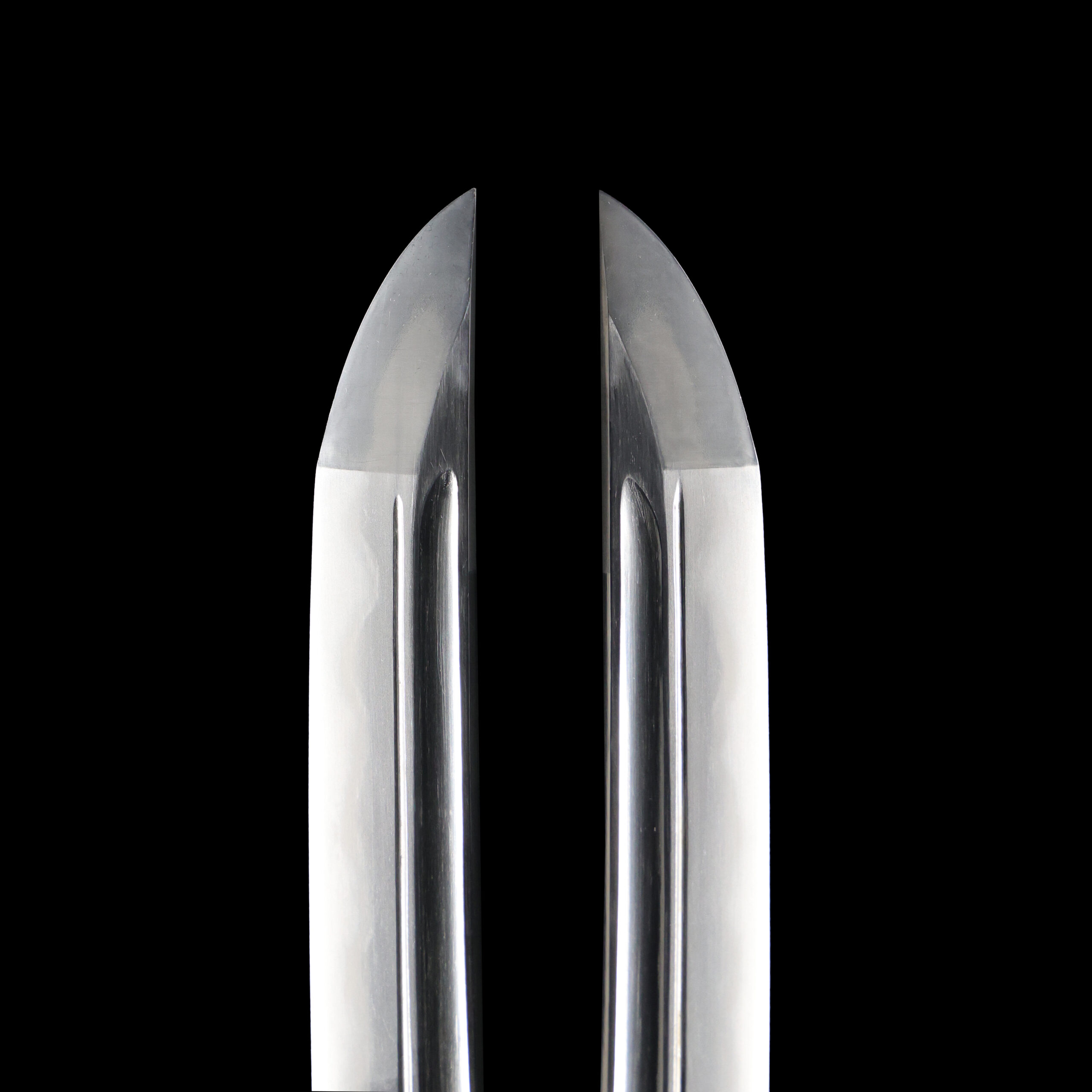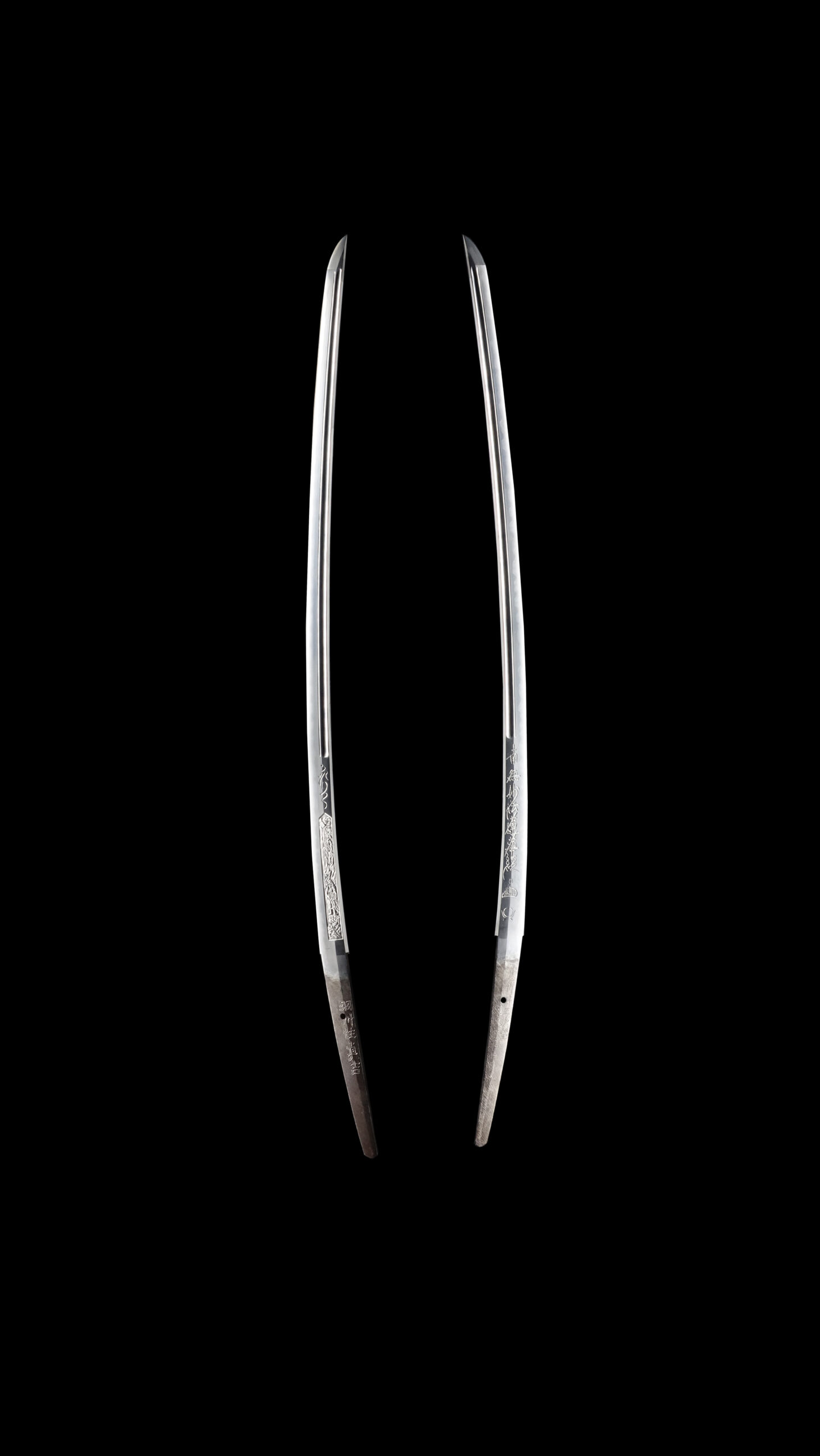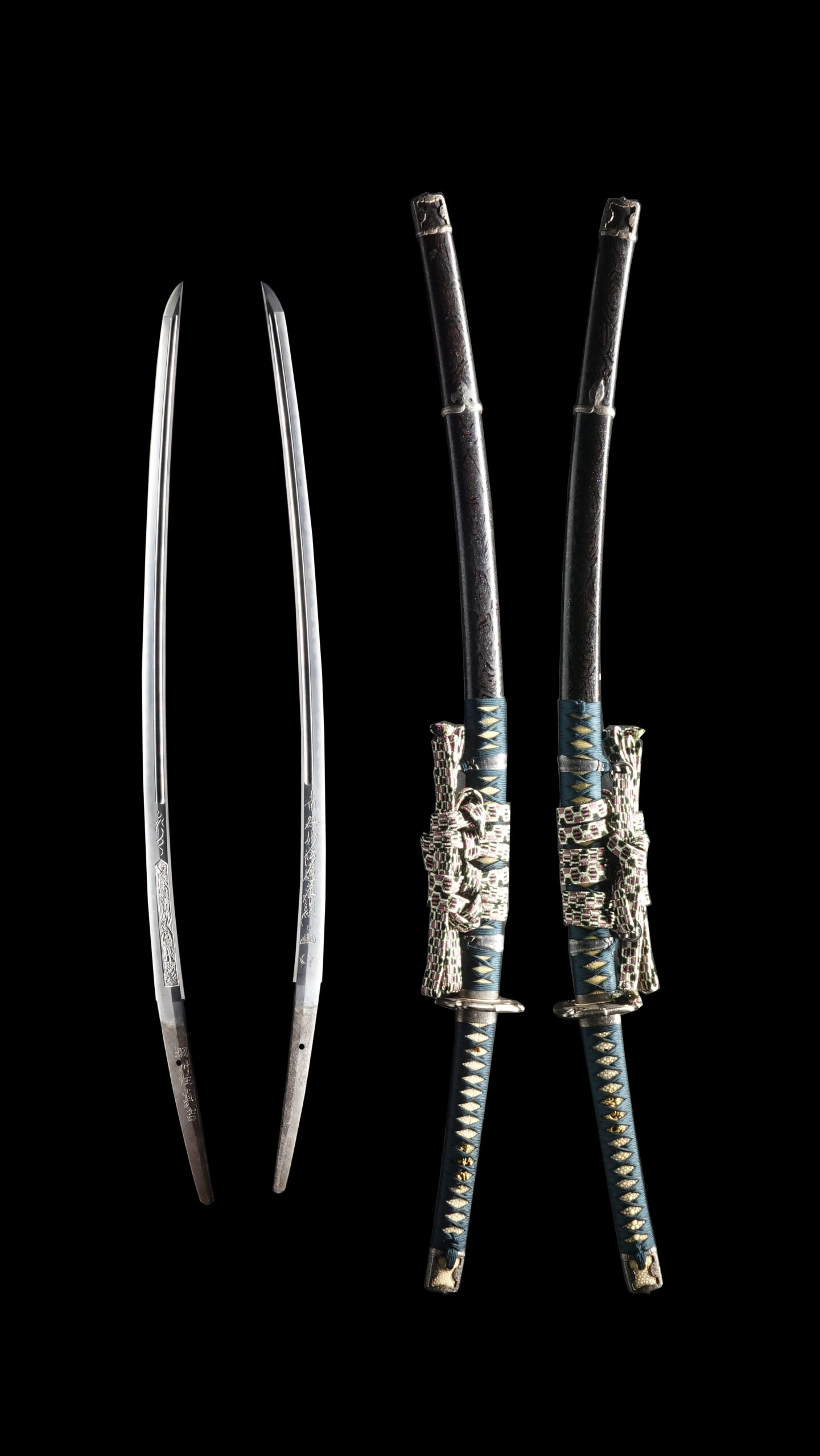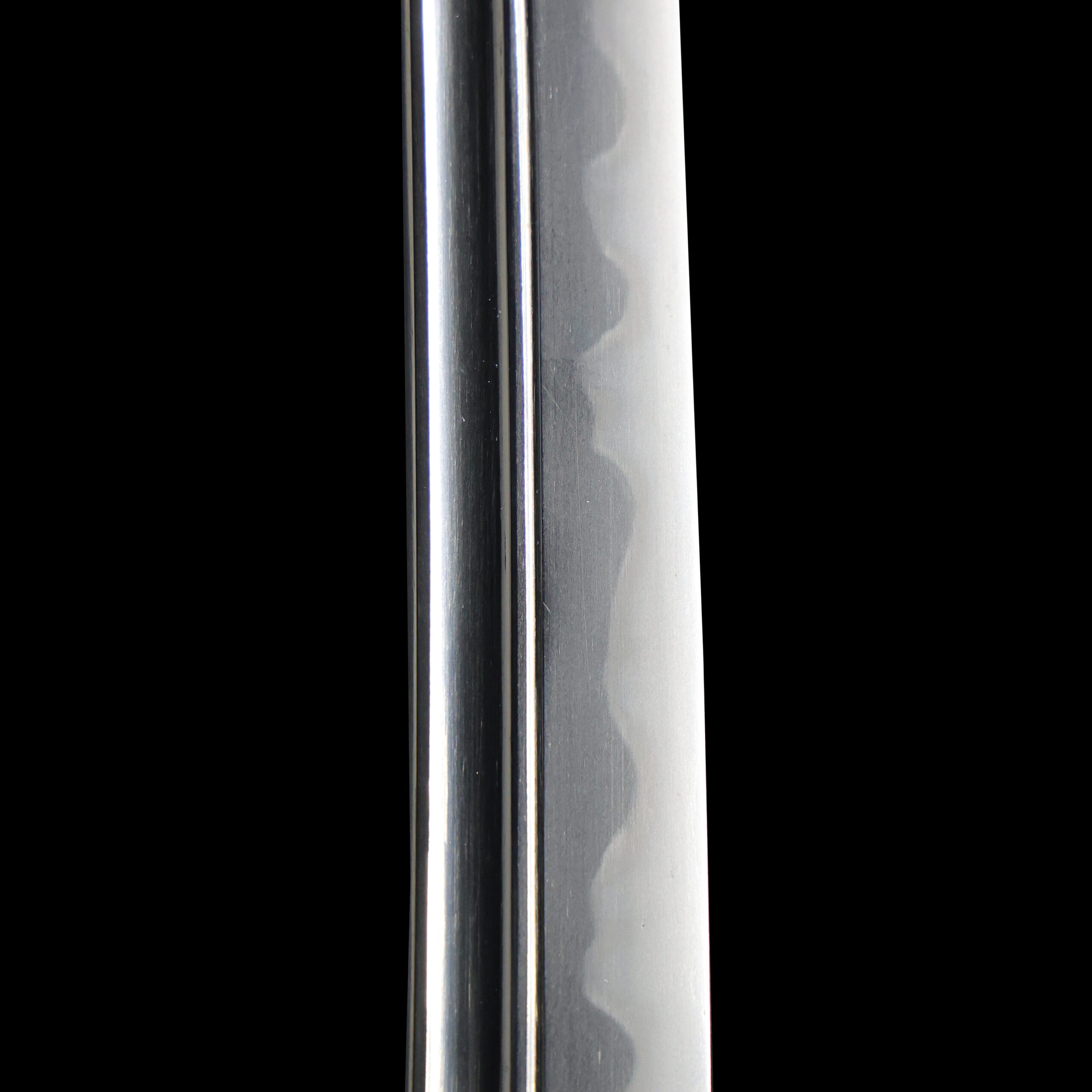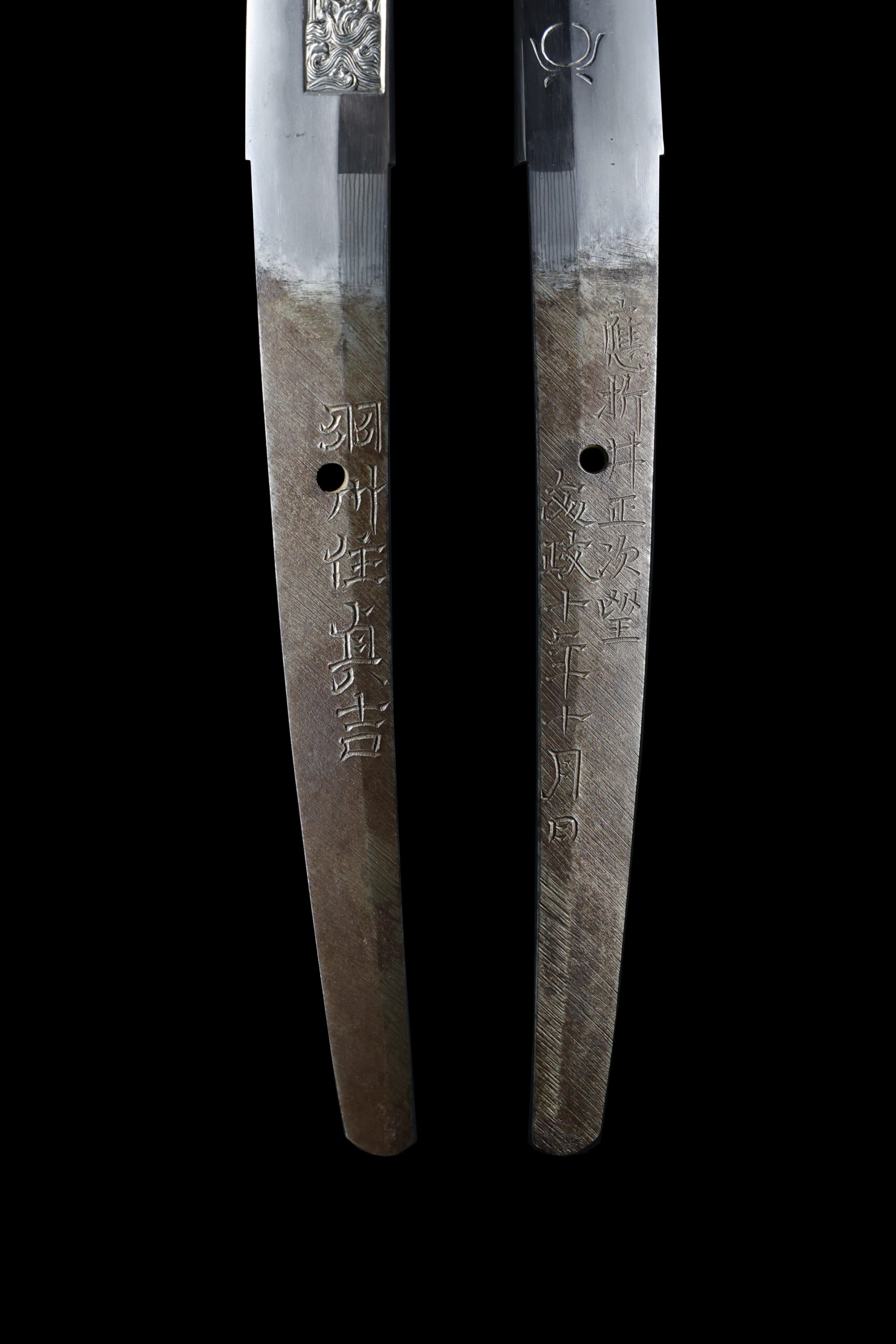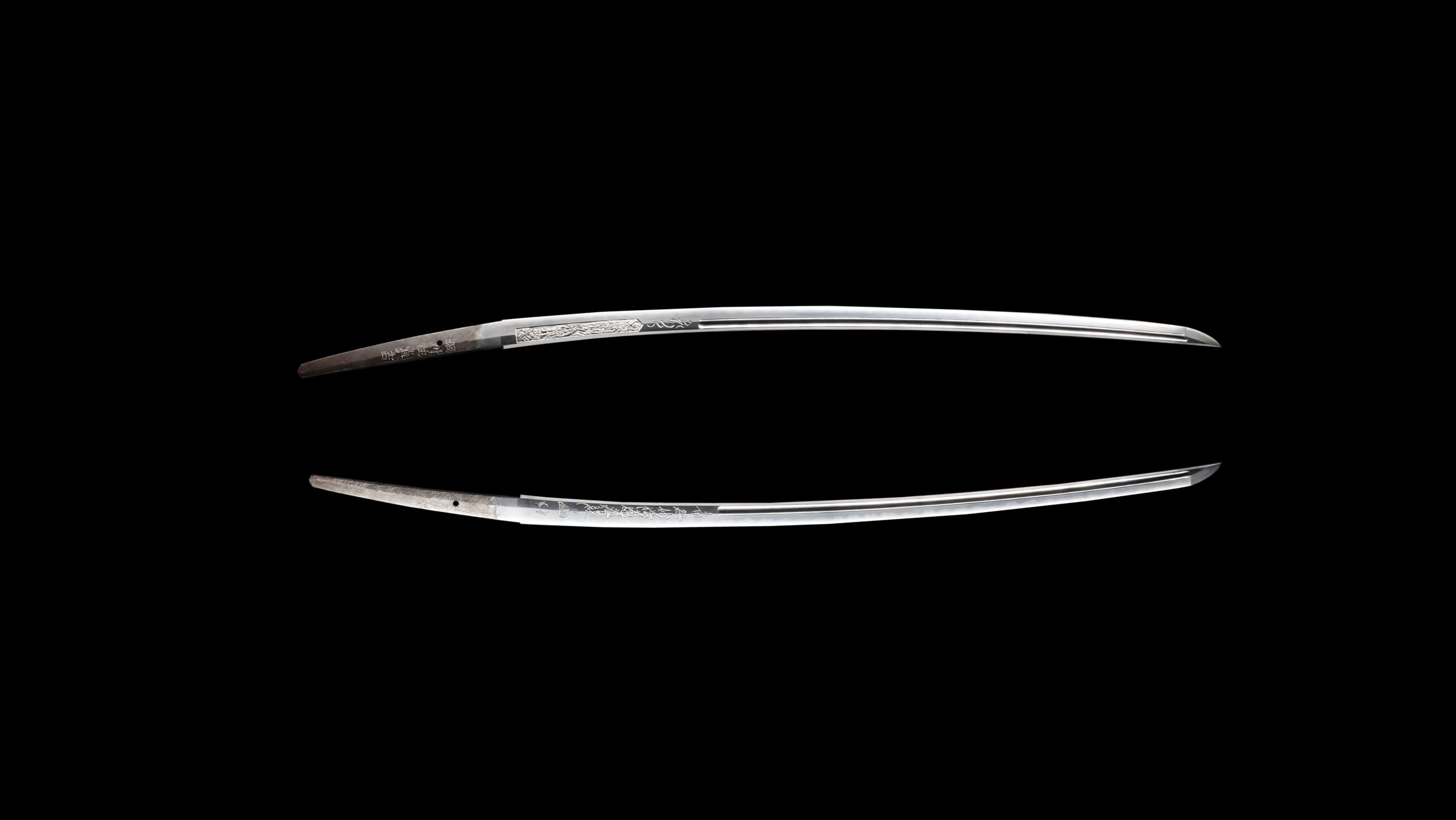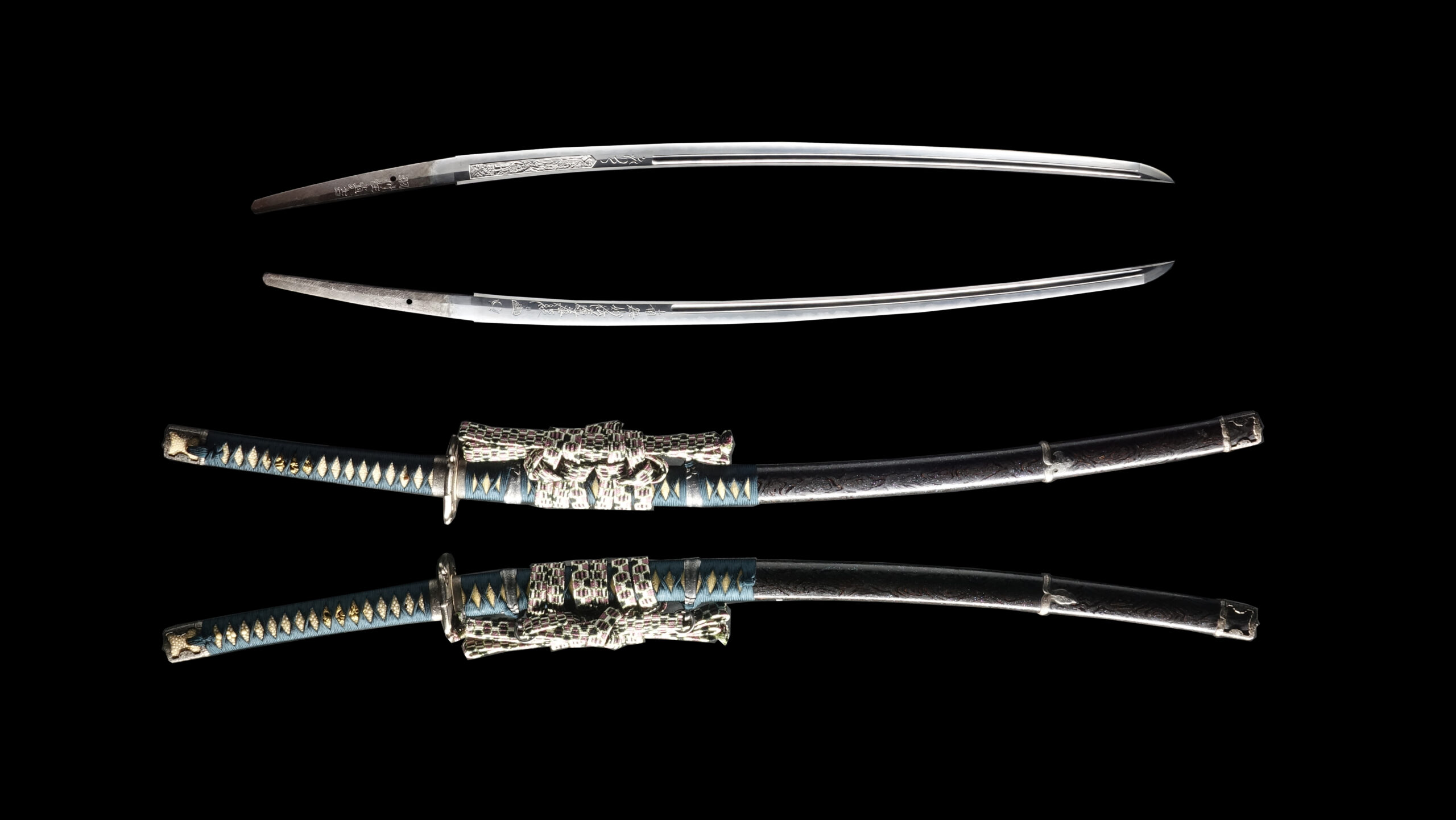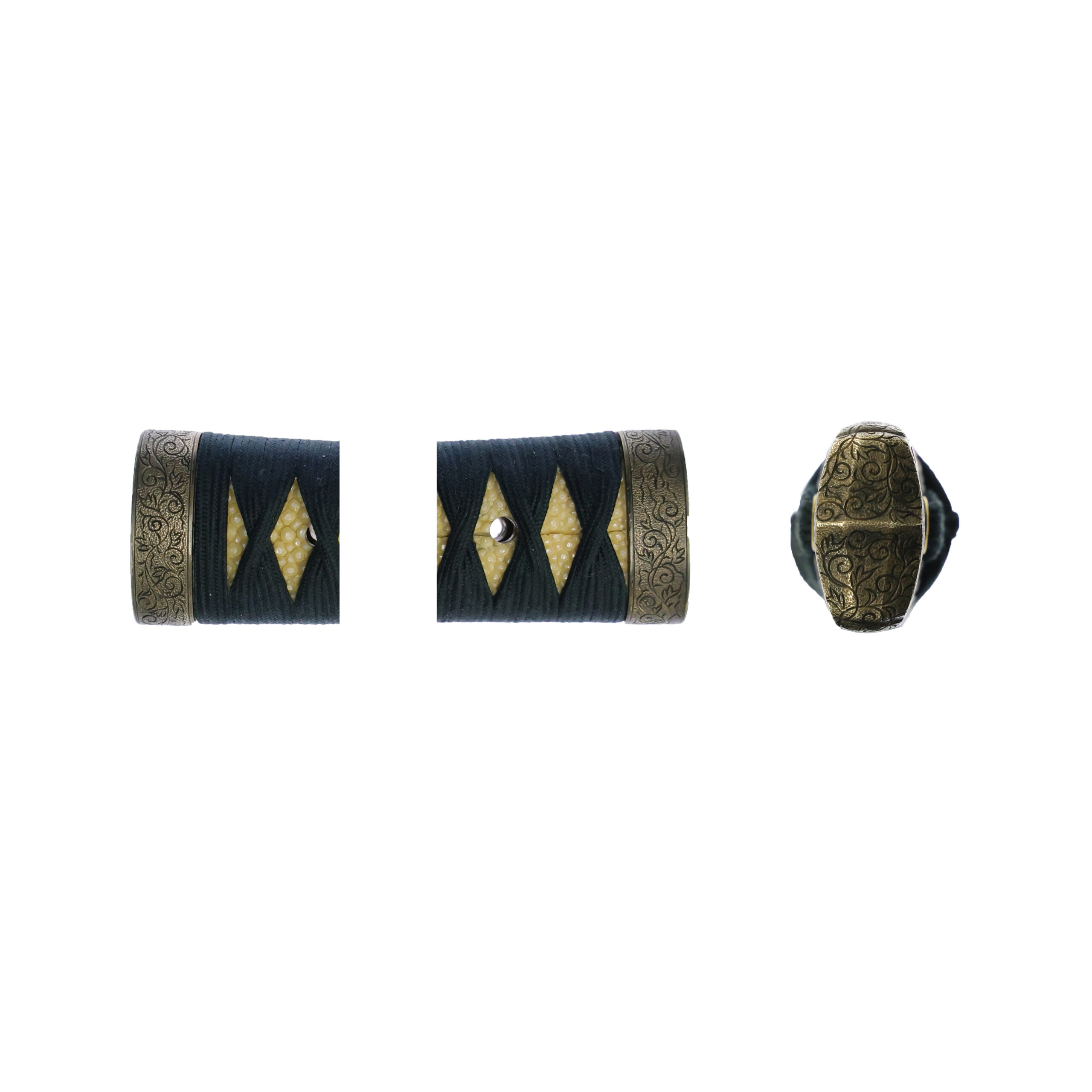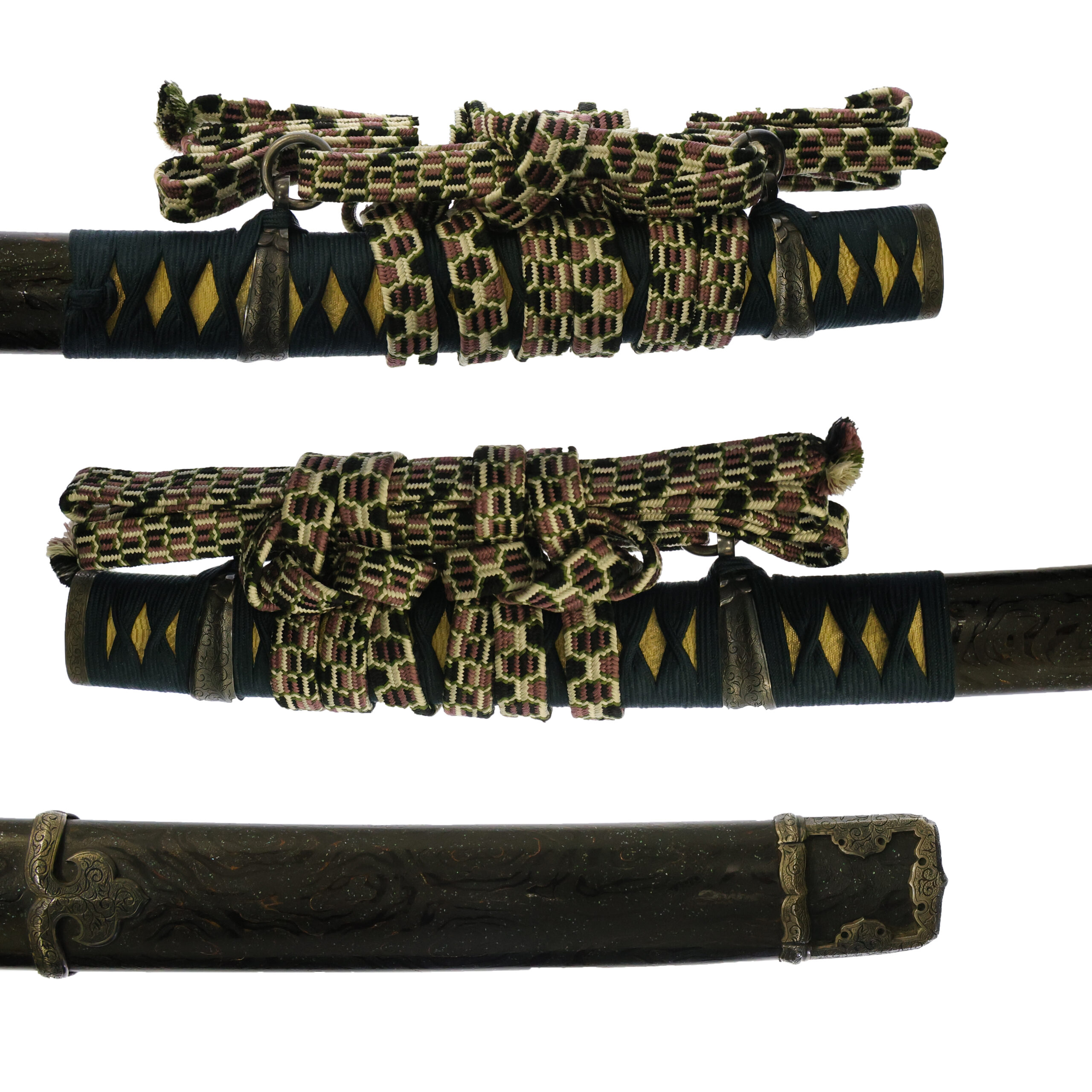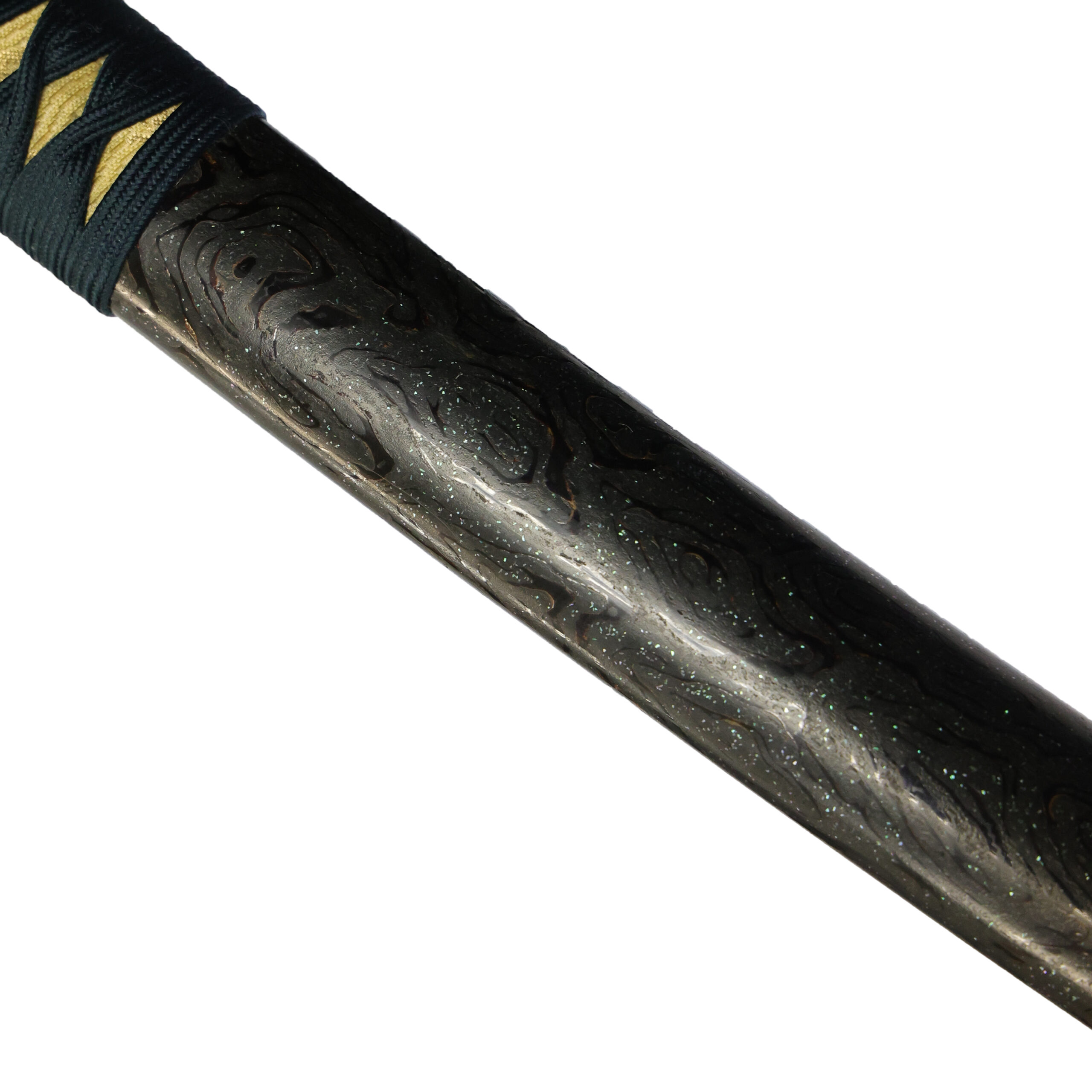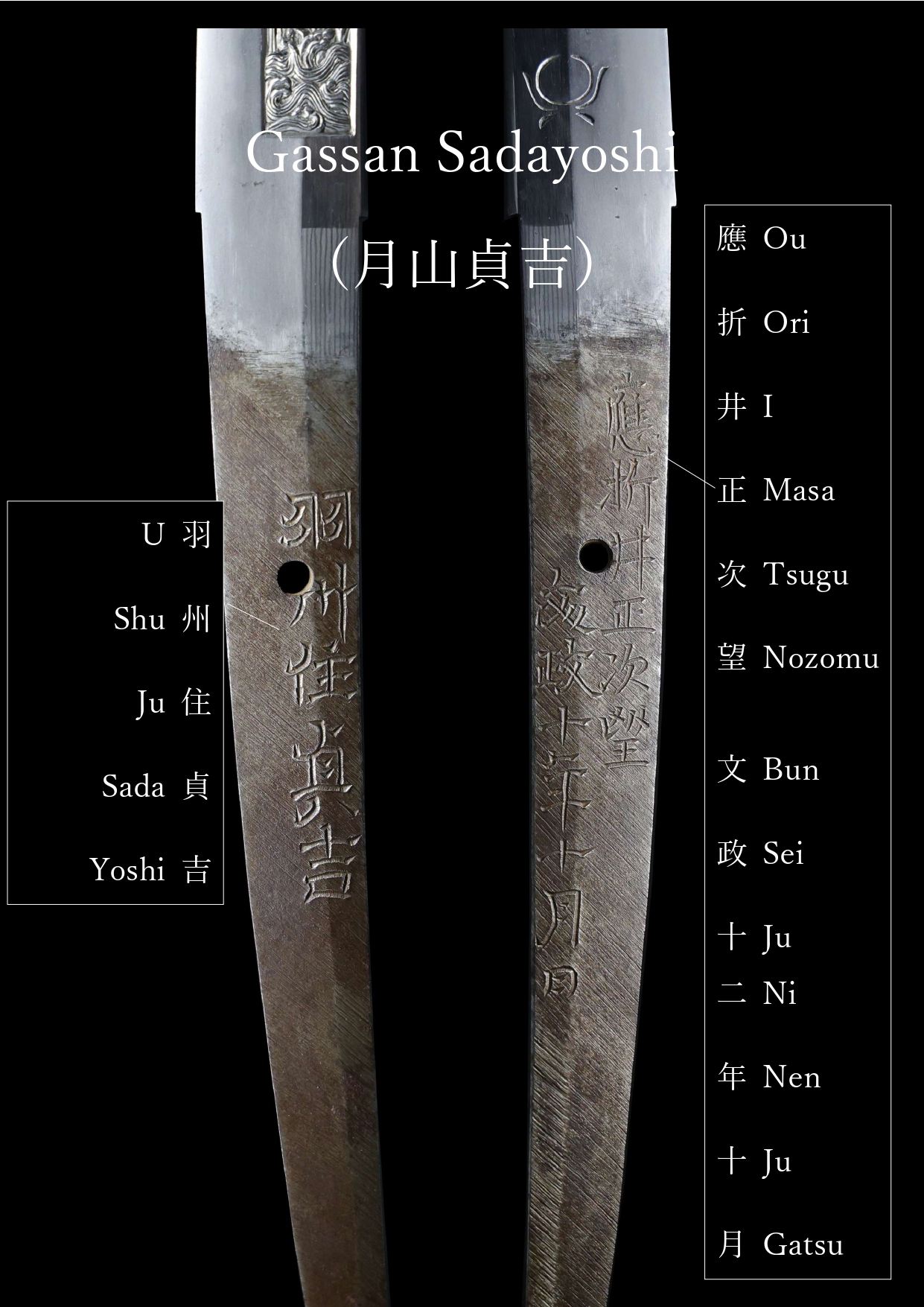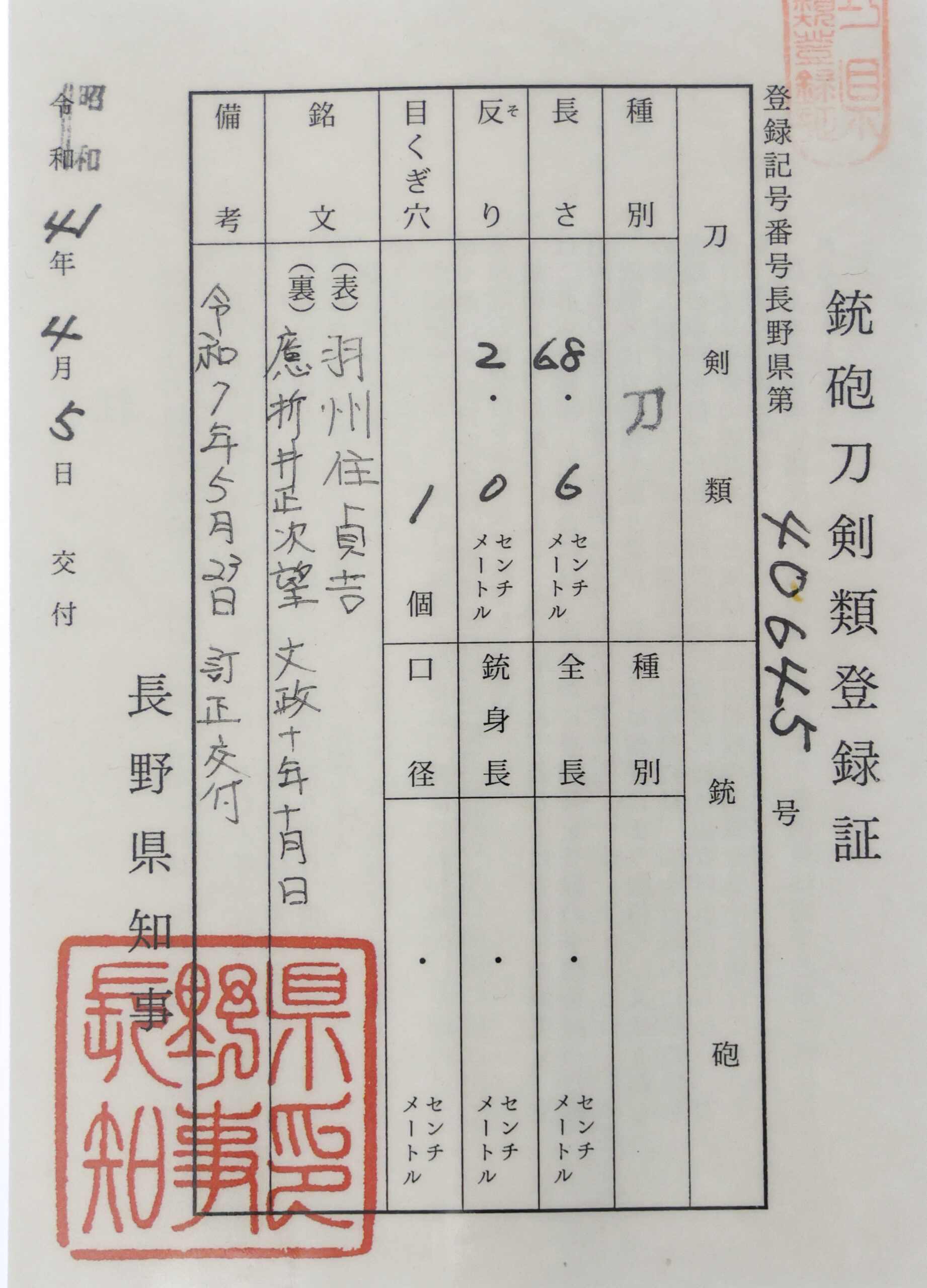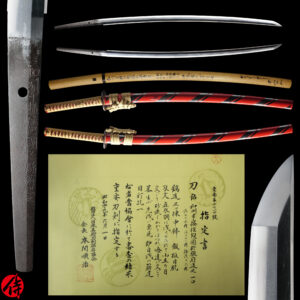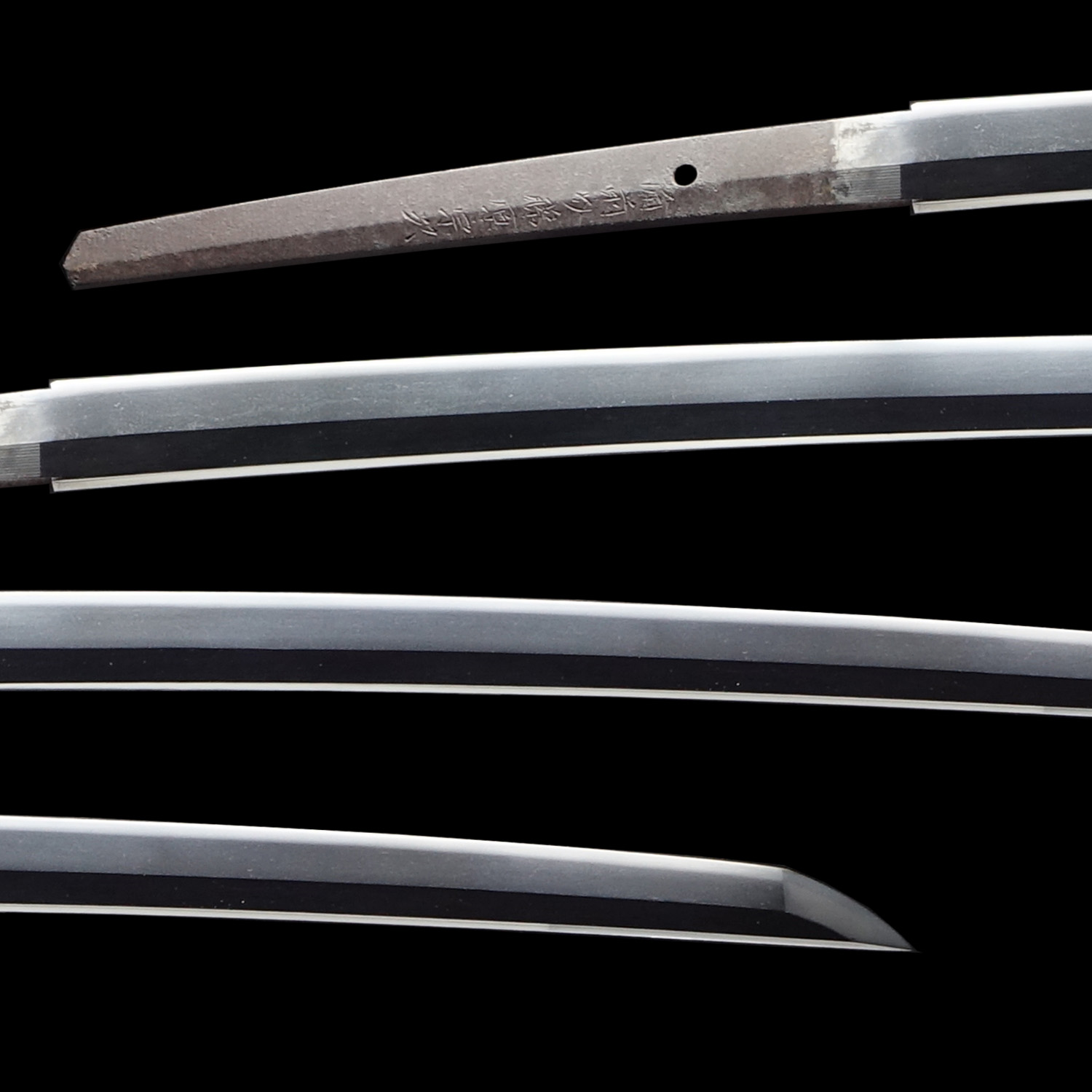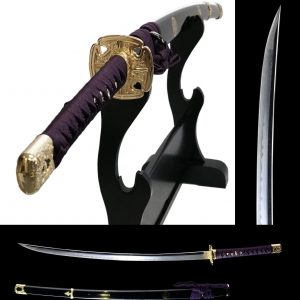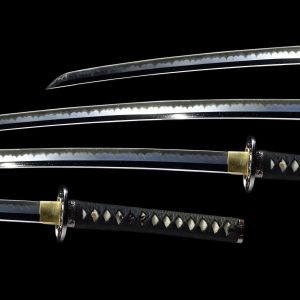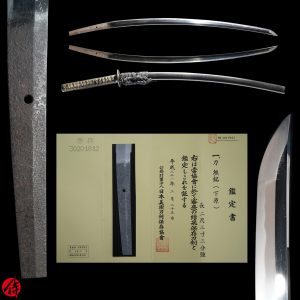Antique Japanese Sword Katana Signed by Gassan Sadayoshi with Tokubetsu Hozon Certificate
【Description】
This blade was signed by Gassan Sadayoshi (月山貞吉) in October of 1827 (the 10th year of the Bunsei era). His real name was Gassan Yahachirō (月山弥八郎), and he was born in Dewa Province (today’s Yamagata Prefecture) in 1781. According to the NBTHK (Society for the Preservation of Japanese Art Swords), the inscription indicates that this blade was made upon request from Orii Masatsugu while Sadayoshi was still living in his birthplace of Dewa.
The name “Gassan” refers to the swordsmith school to which he belonged. The Gassan school originated in the late Heian period (12th century), and its name is said to have come from Mt. Gassan, a sacred mountain in Dewa Province, where the school’s early smiths forged their swords. In his youth, Sadayoshi learned the art of sword-forging from his father, Okuyama Yasaburō Sadachika (奥山弥三郎貞近), who was believed to be a descendant of the Ōshū Gassan school, one of the oldest Gassan lineages.
Around the age of twenty, Sadayoshi moved to Edo (present-day Tokyo) and became an apprentice to the renowned master Suishinshi Masahide (水心子正秀), one of the most celebrated swordsmiths of the late Edo period and the key figure in the Shinshintō (“New New Sword”) revival movement.
After about ten years of training, Sadayoshi mastered advanced techniques and, in 1833 (Tenpō 4), relocated to Osaka. There he founded the Osaka Gassan school, further refining his craft and training many talented apprentices, several of whom went on to become leading swordsmiths of the Bakumatsu era (the end of the Edo period).
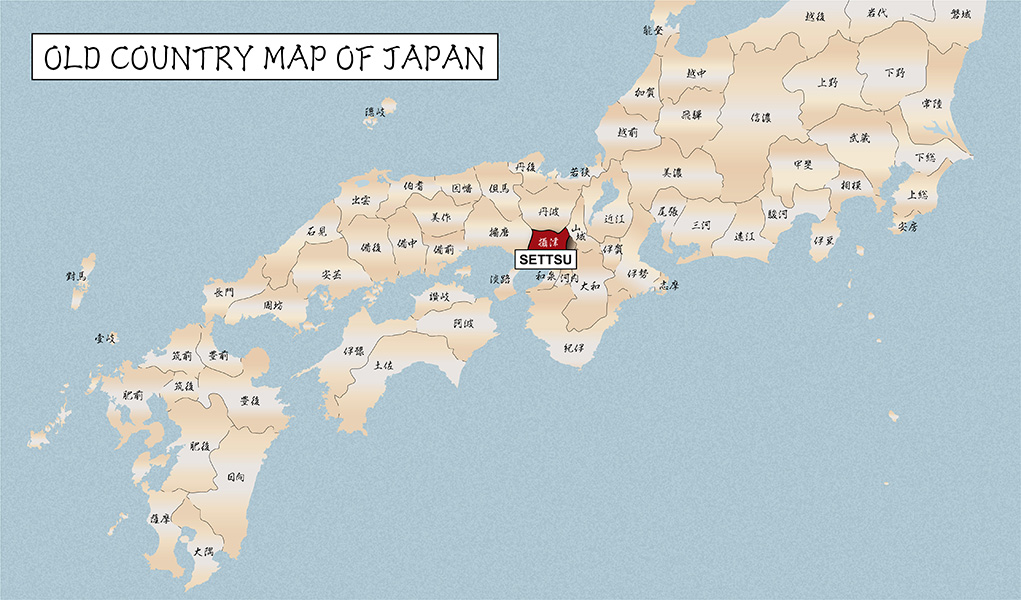
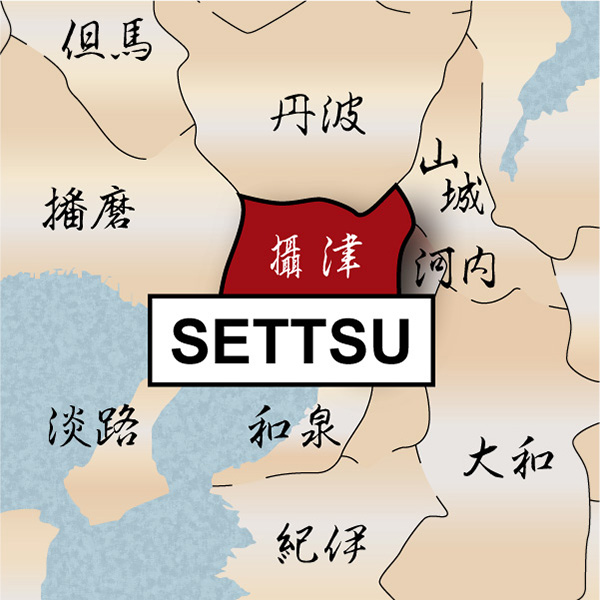
Although the Gassan school had been one of Japan’s most prestigious traditions since the Kamakura period, its influence had declined by the mid-Edo period.
Through Sadayoshi’s tireless efforts and accomplishments, however, the school was revived and regained its former prominence toward the end of the Edo period.
Sadayoshi adopted a son from the Tsukamoto family and named him Sadamitsu (Gassan Sadakazu, 月山貞一), who later became one of Japan’s most famous swordsmiths of the Meiji era. Father and son devoted many years to researching the traditional Gassan forging techniques and eventually succeeded in recreating the Ayasugihada pattern—an undulating grain on the steel surface resembling the grain of Japanese cedar, which became the signature texture of the Gassan school. In addition to Ayasugihada, Sadayoshi also forged blades in various other traditional styles.
Gassan Sadayoshi passed away in 1870 (the 3rd year of the Meiji era) at the age of 71. His adopted son Gassan Sadakazu inherited the tradition, which was then passed down to Gassan Sadakatsu, and the lineage continues to this day. The current head of the family, Gassan Kazutoshi, and his son Gassan Sadanobu, still carry on the centuries-old Gassan tradition, forging authentic Japanese swords in Nara Prefecture today.
Horimono (Engraving)
This blade features beautiful carvings (Horimono) on both sides. On one side, the inscription “Namu Myōhō Renge Kyō” (“Devotion to the Lotus Sutra”) is accompanied by a Rendai (蓮台) design—a lotus pedestal motif often seen as the base of Buddhist statues. The lotus flower symbolizes purity emerging from the mud, a key concept in Buddhist teachings. In sword ornamentation, the upper carving represents the lotus blossom, while the lower portion is the pedestal (Rendai). These motifs are frequently combined with esoteric Buddhist symbols such as Bonji (Sanskrit characters) or Suken (ritual swords), expressing both faith and protection.
On the other side, a Bonji character and an image of Fudō Myō-ō (不動明王, Acala) holding a Kurikara-ken (倶利伽羅剣, Kurikara sword) are carved into the blade.
Bonji are Sanskrit seed syllables that represent Buddhist deities and serve as sacred symbols for invoking divine protection. Among them, the character “Kān” (カーン) symbolizes Fudō Myō-ō, one of the most revered guardian deities among samurai warriors. Another Sanskrit character, “Kanmān” (カンマーン), combines with “Man” to form a sacred mantra. During the age of the samurai, warriors often incorporated such religious motifs into their armor, helmets, and swords as expressions of faith and spiritual strength in battle.
The Kurikara-ken (Sword entwined by a dragon) is the sword held by Fudō Myō-ō in his right hand. A flaming dragon known as Kurikara Ryū-ō (倶利伽羅竜王) coils around the blade, symbolizing the “Sword of Wisdom” that cuts through ignorance, evil, and worldly desires. In esoteric Buddhism, this sacred sword is believed to possess the power to purify the spirit and ward off evil forces.
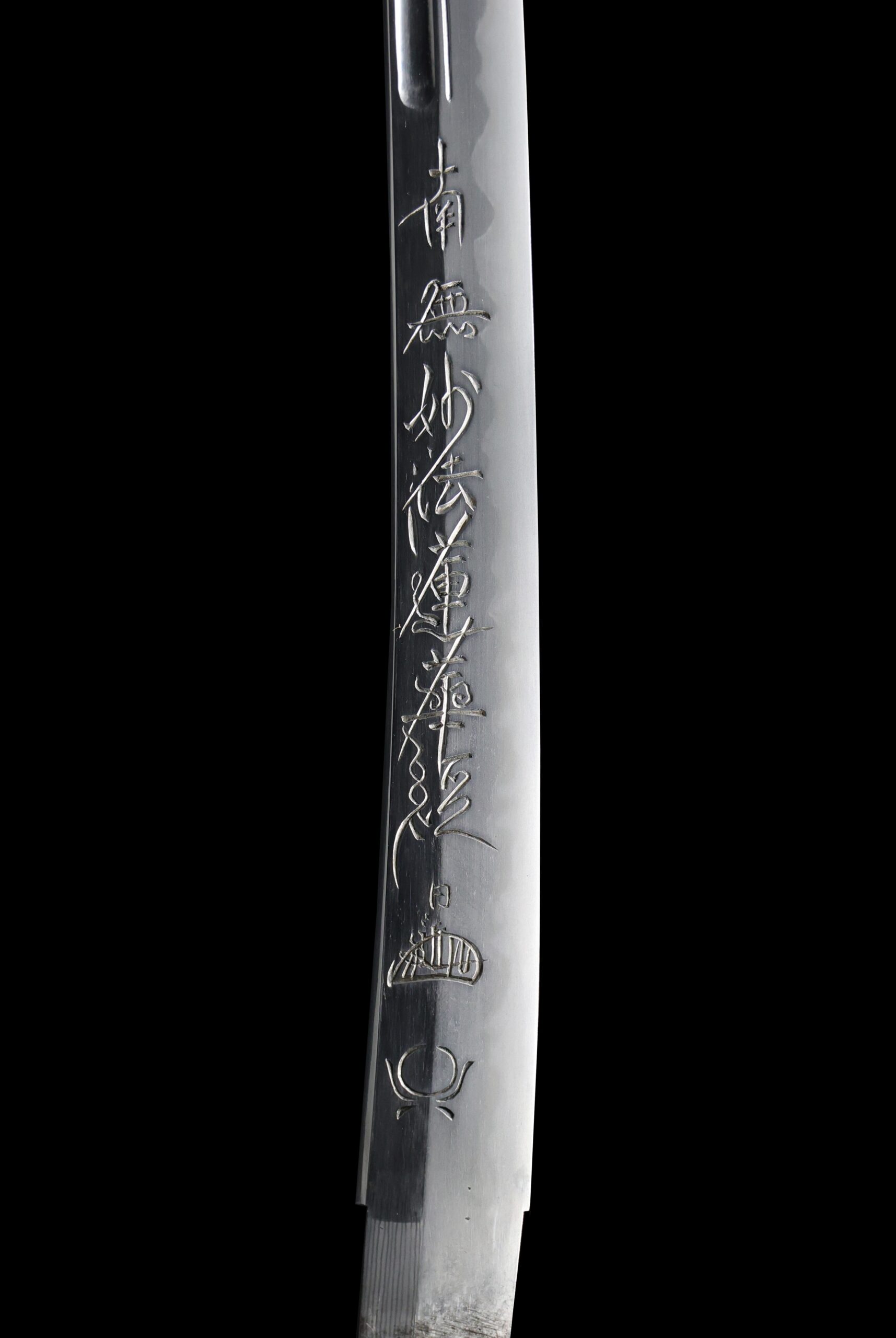
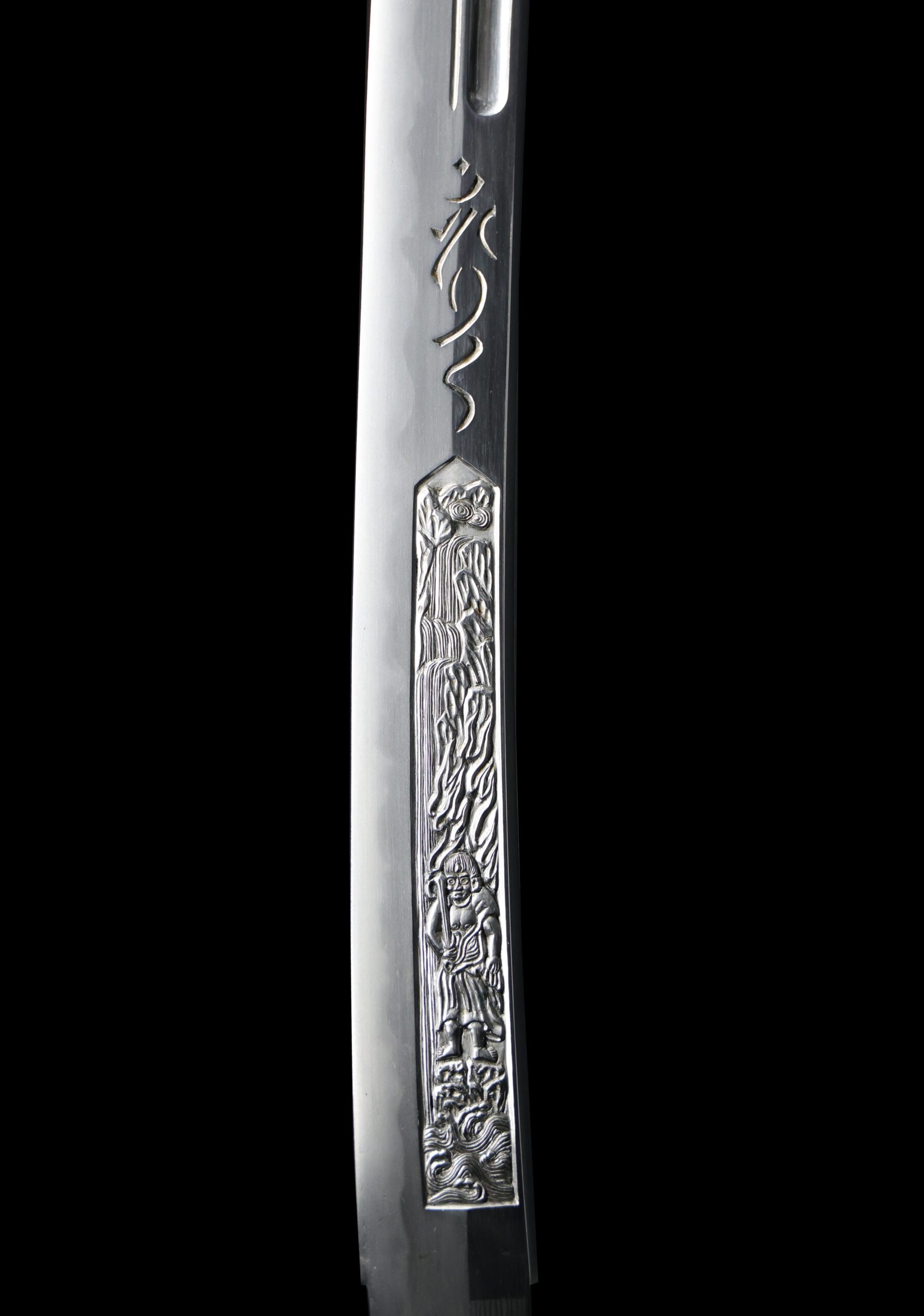
Tachi Koshirae
This blade is stored in Tachi(太刀) Koshirae. Tachi was mainly used by an armored Samurai with one hand on horseback from the Heian period (794-1185 A.D.) until the early Muromachi period. TACHI was suspended loosely on the left waist with its edge facing the ground so that you could draw it faster to cut down soldiers on the ground. Because of its gorgeous looking, having a Tachi-style sword mounting became a social status among Samurai.
It is appraised as a Tokubetsu Hozon Token (特別保存刀剣) issued by NBTHK (Nihon Bijutsu Touken Hozon Kyokai:日本美術刀剣保存協会). This authentication paper was only given to authentic Japanese swords, especially well preserved and high quality with artistic value.
【Blade】
Cutting Edge Length(Nagasa):68.6 cm (27.0 inches)
Curvature(Sori):2.0 cm (0.78 inches)


Hamon:
The crystalline structure which forms along the cutting edge of a blade as a result of the hardening process
Jimon(Jihada):
visible steel surface pattern created by folding and hammering during forging process


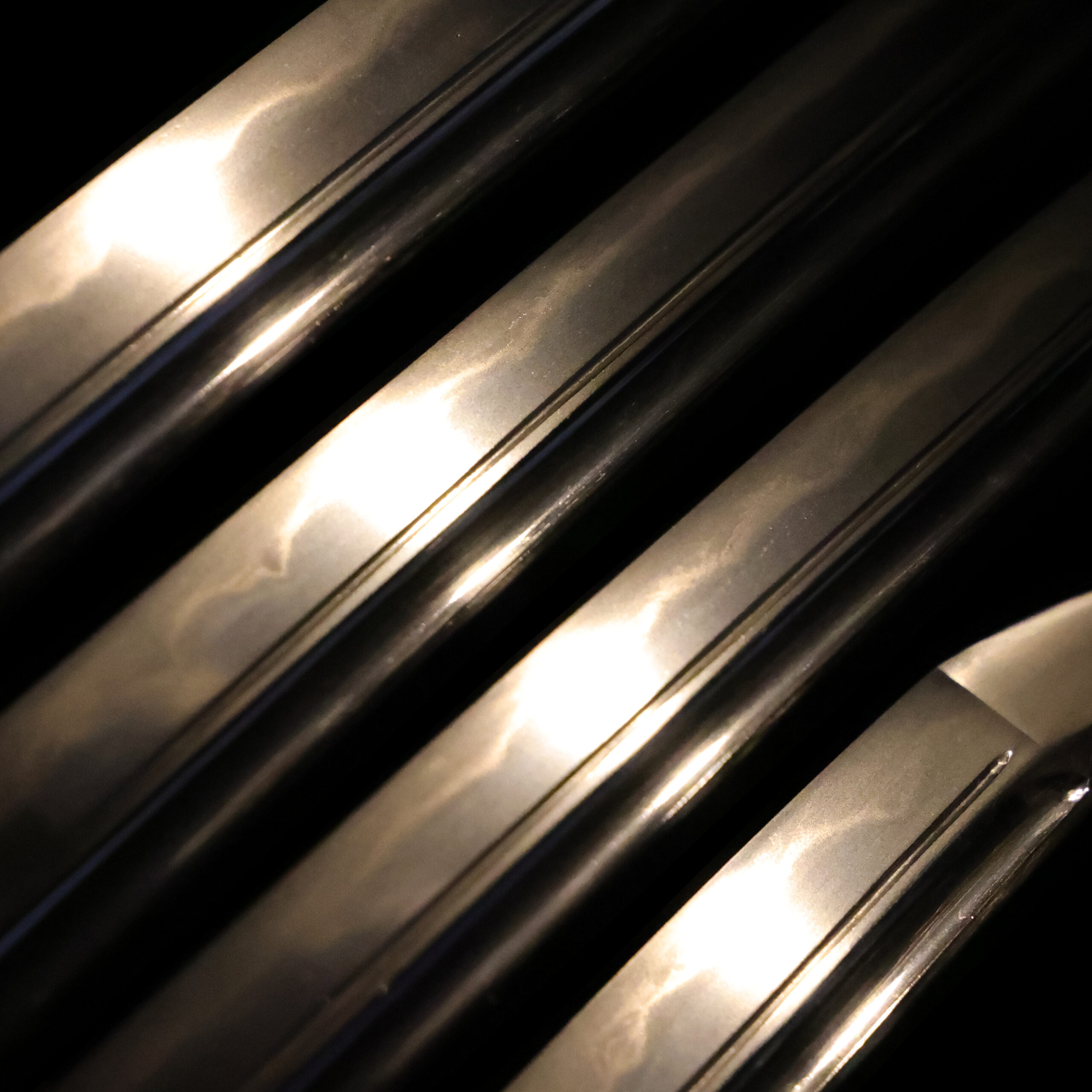
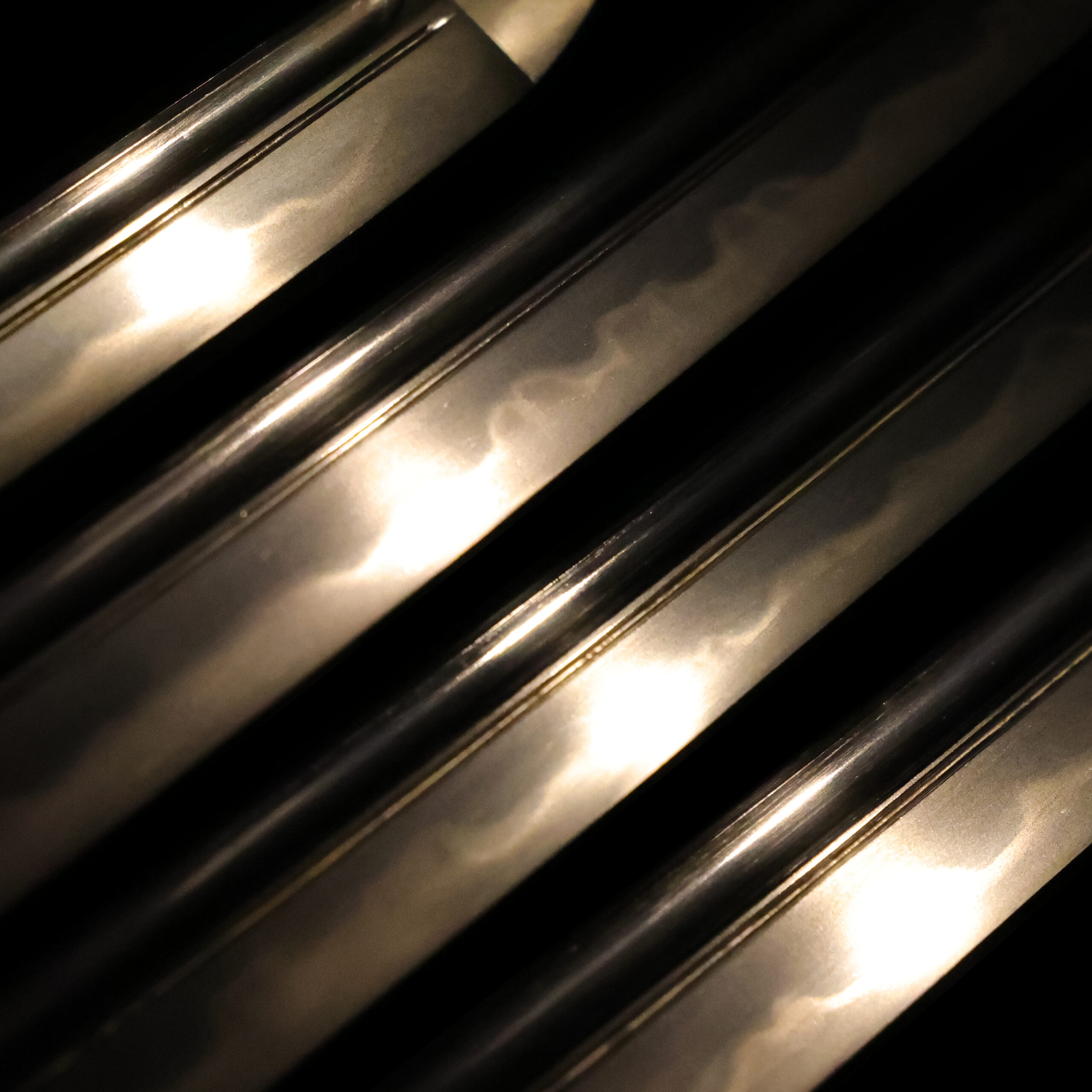
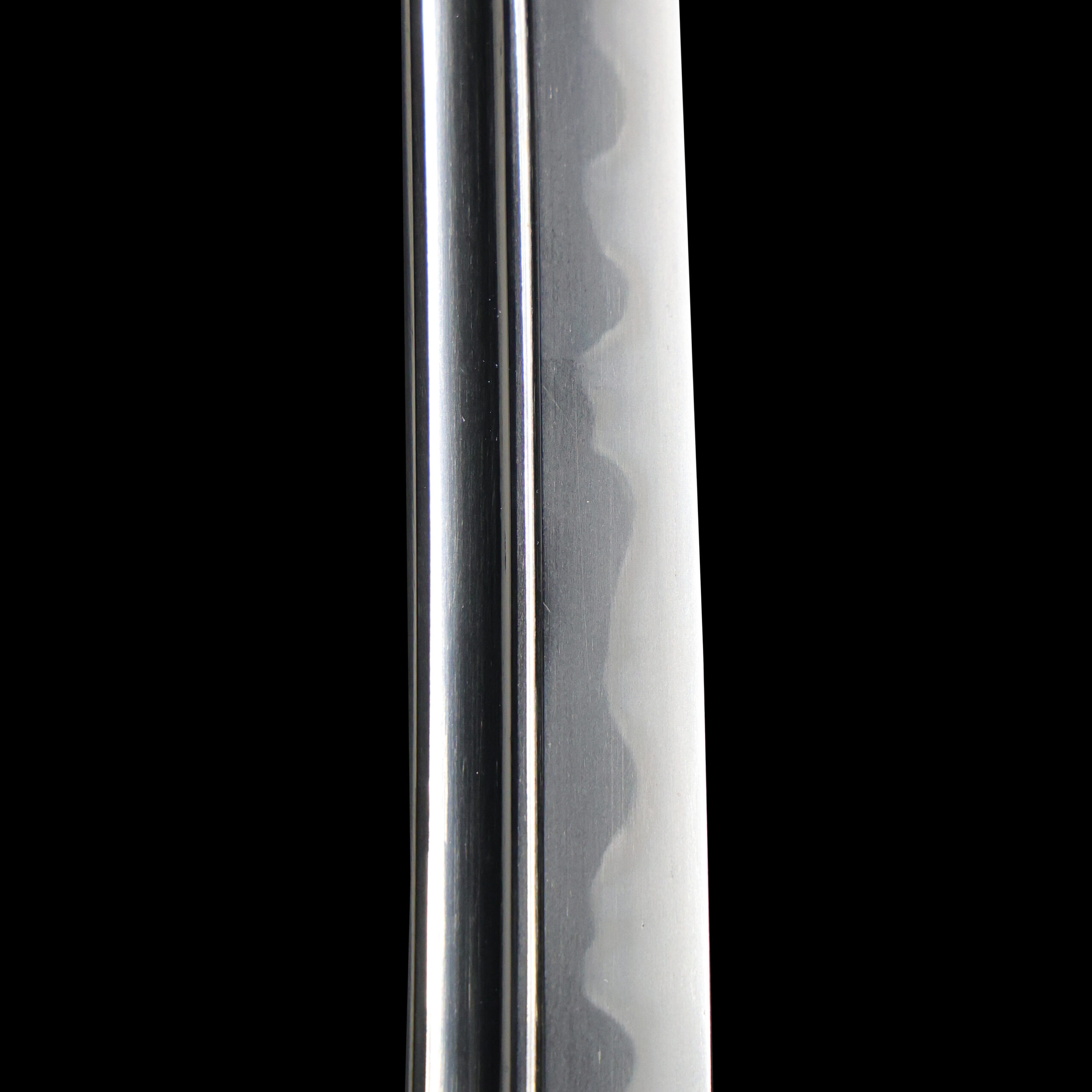

Kissaki:Kissaki is the tip of the Japanese sword.

Nakago:Nakago is the tang of the Japanese sword.
Japanese swordsmiths left the black rust on the tang because it prevents red rust while the tang is in its handle. And the discoloration of the tang was created over time, and it is a great indicator for a Japanese sword specialist to estimate when the sword was forged.
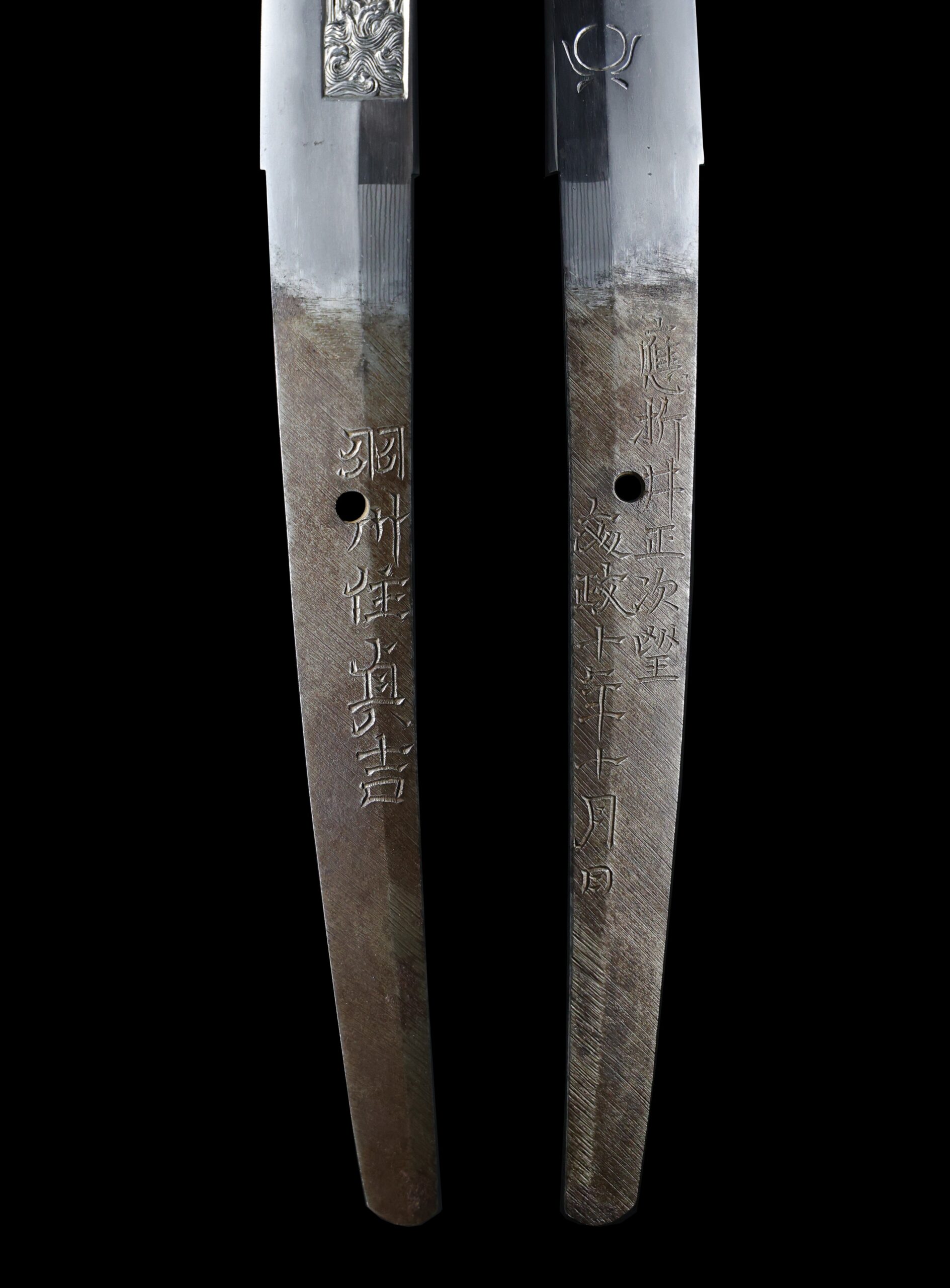
Koshirae:Koshirae is the mounting of the Japanese sword. There are several parts that consist of Koshirae such as Saya (Scabbard), Tsuka (Handle), Tsuba (Handguard).
This type of Koshirae is called a Tachi-koshirae (太刀拵え), designed to be worn hanging at the waist. It is not intended for practical combat; instead, its purpose was to signify the authority and dignity of the Samurai who carried it, or the powerful figures they served. As a result, it is characterized by the luxurious decorations and colors.

Fuchi-Kashira:A pair of matching sword fittings that cover the upper and bottom parts of its sword hilt.
The Fuchi and Kashira are decorated with the same design. It is a pattern of curved and intertwined vines. This design is called the Karakusa (唐草, arabesque) pattern. Other sword mountings and metal fittings of this Koshirae have the same design, such as the Tsuba, Ishiduki Kanamono (石突金物, a fitting attached to protect the distal end of the scabbard), etcetera.
The Karakusa pattern is a design in which stems and leaves of vines are twined and make curves. Since ivy has a strong vitality and grows up without interruption, people regarded this design as a symbol of prosperity and longevity. Vine is called Tsuru (蔓) in Japanese and has another pronunciation; “Man.” There is a word 万 (it is also read Man), which means ten thousand. In the Karakusa pattern, leaves and vines are connected like Obi (帯, belt). The word “帯” can also be read as “Tai.” Due to its pronunciation, the term “代 (Tai)” is associated. From this word-association game, an idiom 万代 is associated, meaning a thousand generations. In other words, we could imagine that people used this design wishing prosperity and longevity for their clans for a long time.
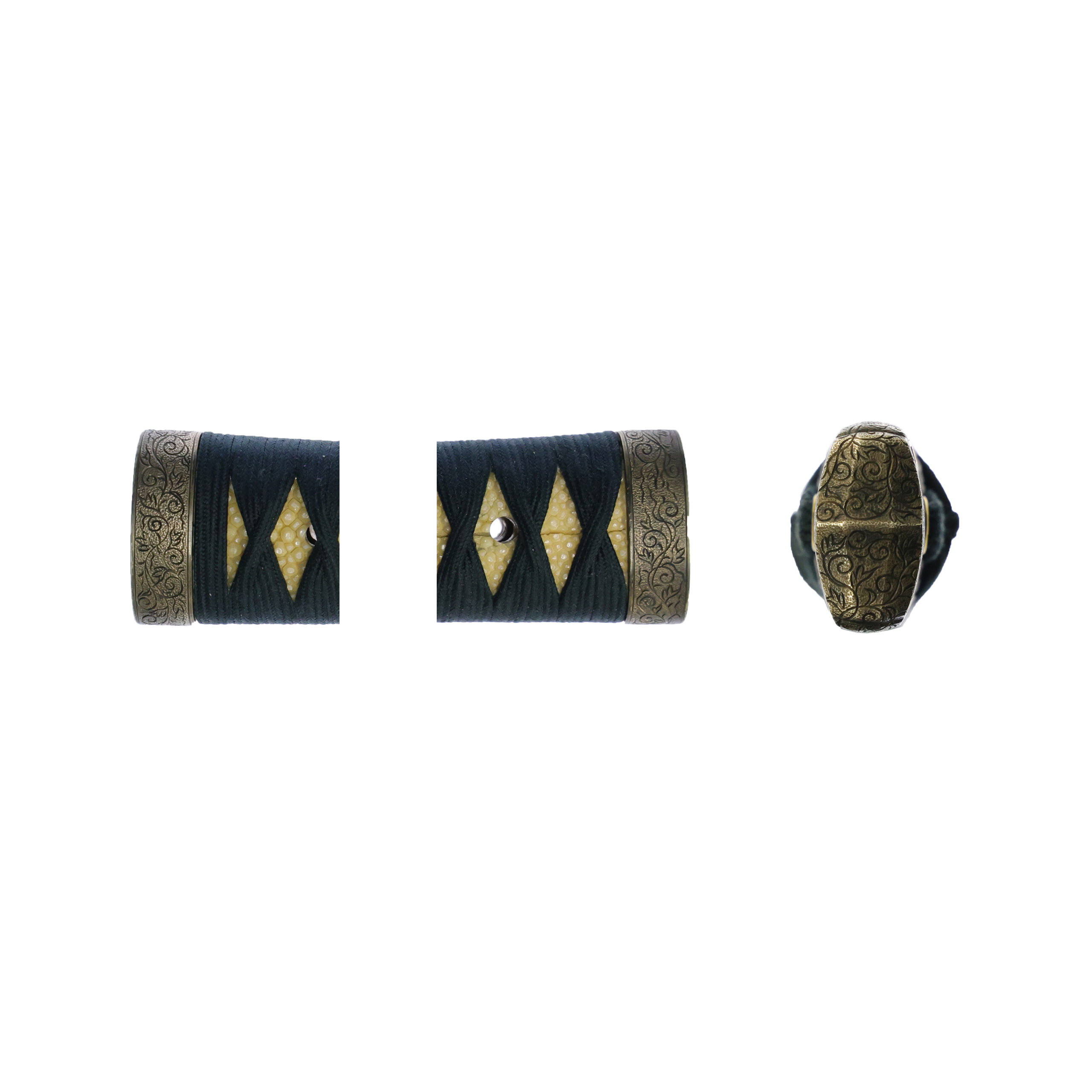
Tsuka and Menuki:Tsuka is the handle of the Japanese sword and Menuki is its decoration.
The motif of this Menuki is the dragon. Initially, the dragon is an imaginary creature found in ancient Chinese traditions or myths. Furthermore, it is regarded as a symbolic beast of auspicious signs. Its body is likened to nine animals: antlers are deer, the head is a camel, eyes are demons, the neck is a snake, belly is Mizuchi (蛟, mythical animal in Japan which looks like a snake and have a horn and four legs), scales are fish, claws are falcons, palms are tigers, and ears are cows. It was thought that the dragon would reign at the top of all animals because of its odd-looking appearance.
In ancient China, the dragon pattern was used for emperors’ clothing so that people strictly defined its shape or even the number of nails. On the other hand, the dragon pattern does not have detailed rules to represent classes in Japan. However, still, it maintains its meaning as the all-purpose auspicious pattern.
Also, in Japan, there is a belief that worships dragon as a water god and is called Ryujin Shinkou (竜神信仰). Since rice cultivation flourished in this country, water is always an essential resource. Therefore, the dragon motif has been familiar to Japanese people since a long time ago.

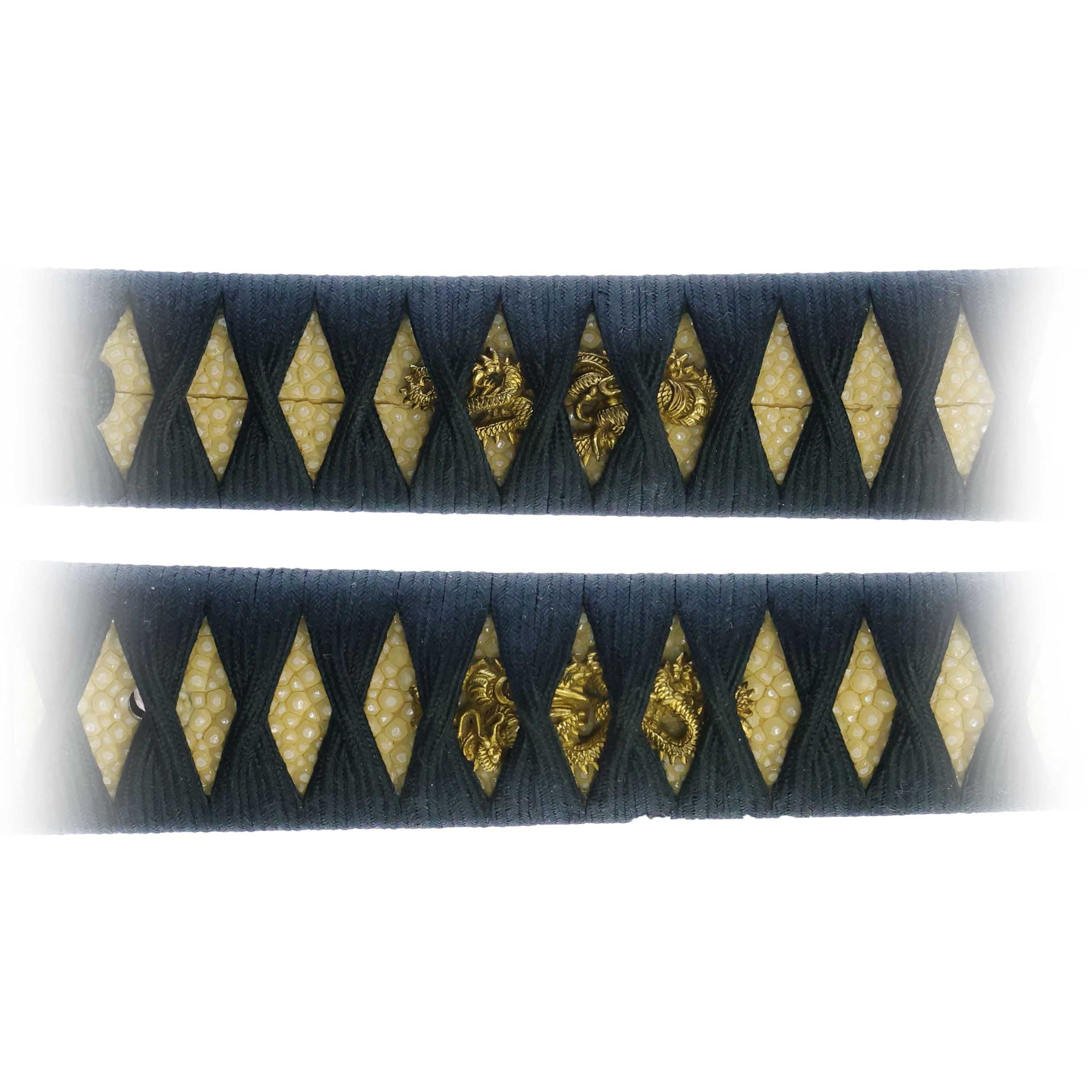
Tsuba and Habaki:Tsuba is the handguard for the Japanese Sword and Habaki is the equipment to make the blade not touch its scabbard inside. It prevents the blade from getting rusty and chipped.
This Tsuba is crafted in the shape of a mokko (木瓜, “four-lobed”) form, which is derived from the stylized outline of a chrysanthemum flower (菊, kiku).
Within each of the lobed sections, the openings are shaped like inome (猪目) — heart-shaped designs that have been used in Japanese art and architecture since ancient times. The inome motif, literally meaning “boar’s eye,” was traditionally believed to ward off evil spirits and invite good fortune, while also adding a graceful decorative touch.
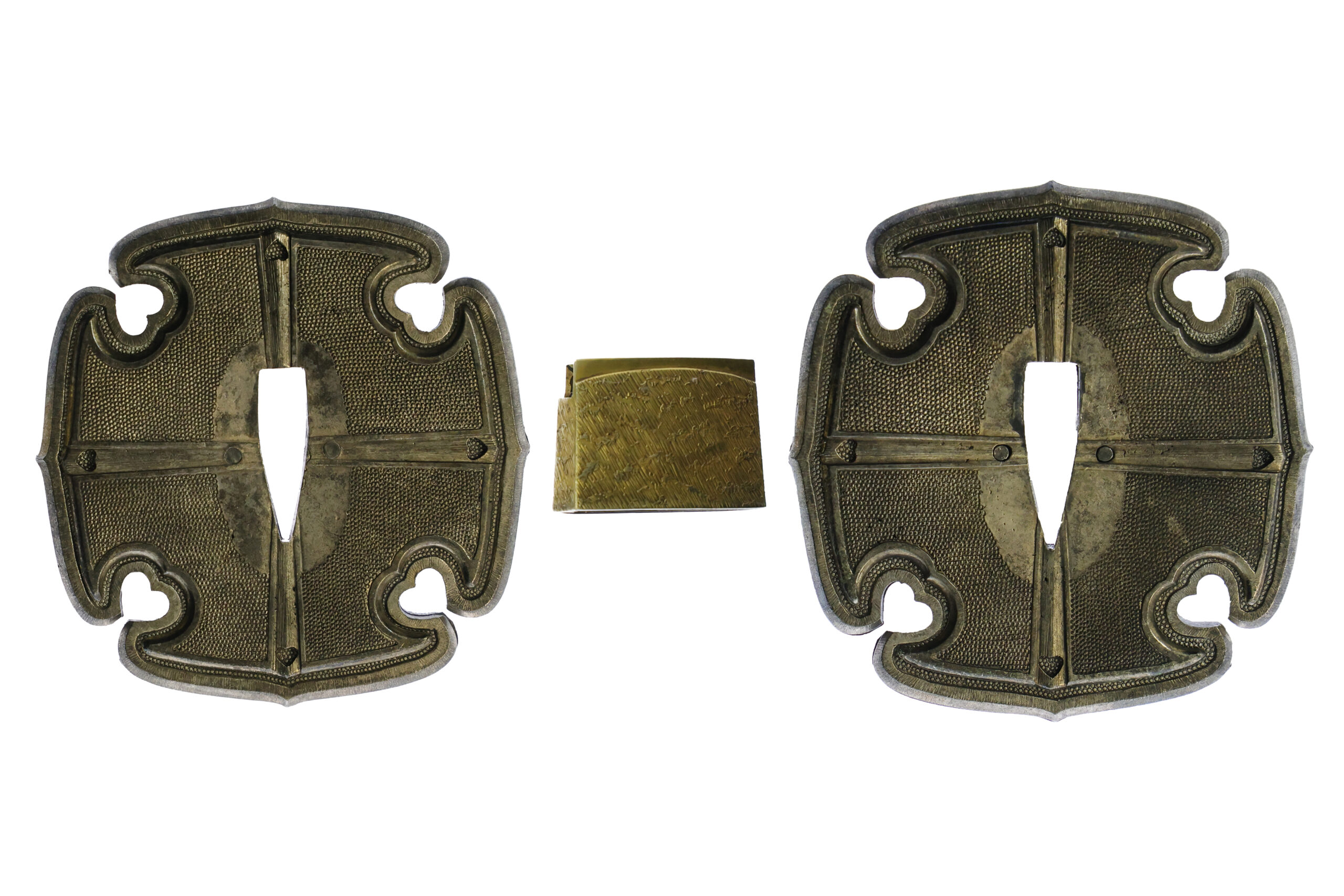
Saya:Saya is the scabbard for the Japanese sword.
The surface of this Saya is decorated with raden(螺鈿), a traditional Japanese decorative technique. Raden involves inlaying or embedding thin pieces of shell, such as mother-of-pearl or abalone, into lacquer or other materials. The shimmering, iridescent quality of the shells creates a striking visual effect, reflecting light in a play of colors that range from soft pastels to vivid hues. This technique has been used in Japan for centuries, adorning everything from furniture to accessories and weapons, showcasing the skill and artistry of the craftsman.
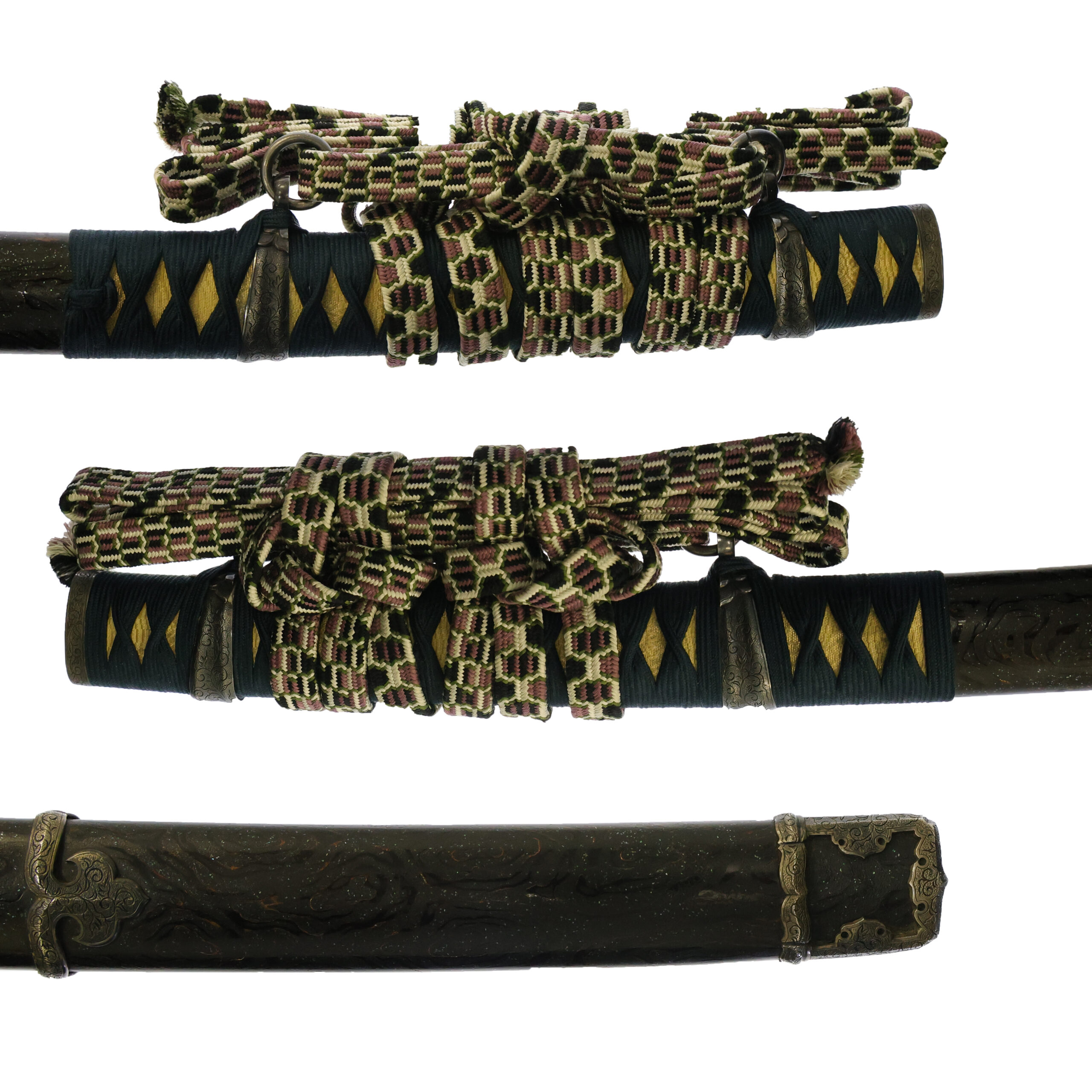

Authentication Paper:NBTHK TOKUBETSU Hozon Certificate for the blade (No. 1023877)
NBTHK, also known as Nihon Bijutsu Touken Hozon Kyokai (the Society for the Preservation of the Japan Art Sword), is one of the oldest Japanese sword appraising organizations in modern-day Japan. They authenticated the blade on December 4th in the 6th year of Reiwa (2024). They appraised it as Tokubetsu Hozon Touken, the blade especially worth preserving for Japanese society. The purchaser will receive this original certificate as well. We can also translate what is written into English and make a PDF file for your record if you request.

Registration Number : Nagano 40645
The Board of Education in Nagano prefecture issued a registration paper for this sword. It is called Jyu Hou Token Rui Tourokusho (銃砲刀剣類登録証). Bunkacho (The Agency for Cultural Affairs) acknowledges a Japanese sword with this paper as a work of art.
The sword needs to be traditionally hand-forged and made of Tamahagane carbon steel to be registered in the system. With this paper, its owner in Japan can legally own an authentic Japanese sword. Based on this registration number, we will apply for its export permit.
This paper will need to be returned to the board of education when the sword is being shipped abroad, but you can receive a copy of it. An English translation of this registration paper is available on request.
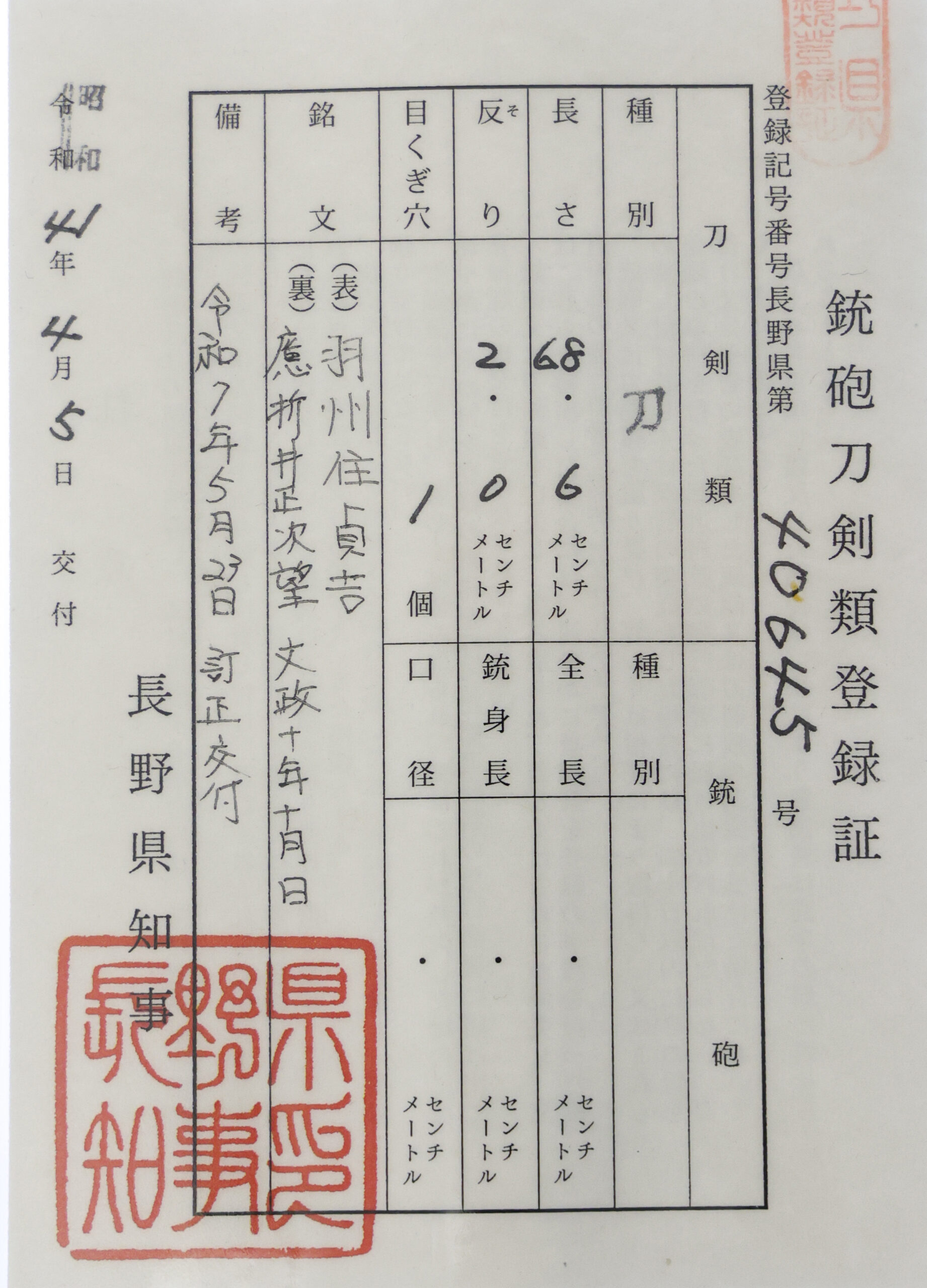
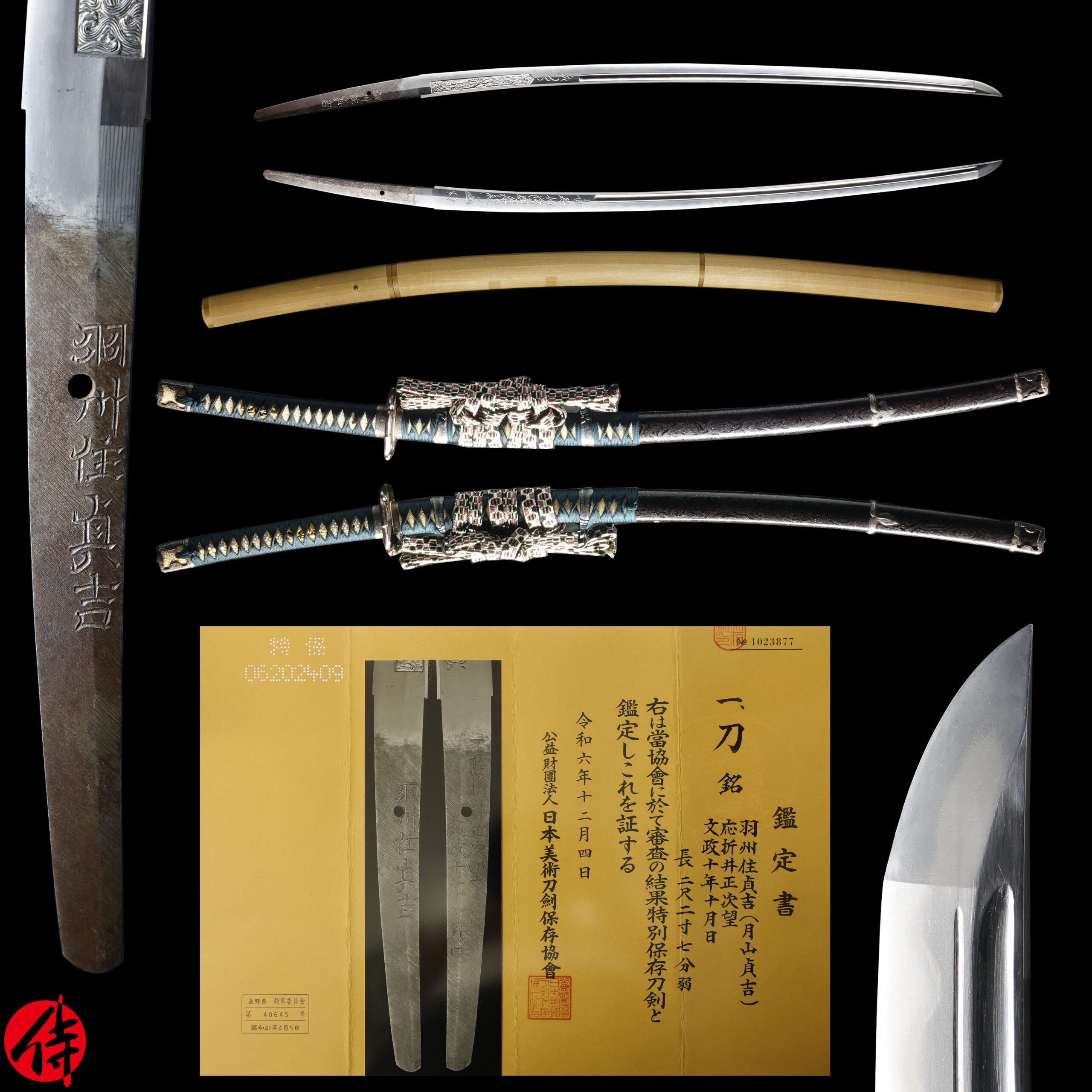
—————————————————————–
【About us】
Samurai Museum is located in Tokyo, Japan, exhibiting antique artifacts related to the Samurai history. Samurai Museum Shop is the place for those who are interested in Japanese culture and craftsmanship. We deal with antique Samurai swords/armor, traditional crafts made in Japan and so on.
【Japanese Sword& Export Process】
The Japanese swords we deal with are hand-forged edged swords made in Japan. It was made from the traditional carbon steel called TAMAHAGANE(玉鋼). Samurai Museum is familiar with the proper legal procedure for an antique/ authentic Japanese sword to be exported from Japan. We have sent more than 1000 Japanese swords for the past few years (~2025) to amazing owners who appreciate its historical value.
Each Japanese sword is registered under the Agency for Cultural Affairs and the Board of Education in Japan. They issue a registration paper for each Japanese sword for its owner in Japan to legally possess it. The Japanese sword with its registration paper means it was traditionally hand-forged in Japan.
To legally export the sword from Japan to other countries, we will have to apply for its permit to the Agency for Cultural Affairs(Bunkacho) and return the original registration paper to the Board of Education. It normally takes around 2-4 weeks to receive this permit after submitting required documents. And we would like you to expect at least 1-1.5 months for your order to arrive at your given address after you ordered. For more detailed info, please click here.
It is allowed for residents in Japan to own authentic Japanese swords without a special license as long as they come with registration papers. Please feel free to contact us if you are a resident of Japan, whether temporarily or permanently. We will also assist you when you leave Japan and need to obtain the export permit.
【Payment Method】
We accept payment through Stripe (Credit card), PayPal, Apple Pay or ChromePay, all of which are secure payment methods. Also, you don’t need to make an account on Stripe for the checkout. If you prefer other payment method, please contact us. After confirming your payment, we will apply for an export permit. You may either pay in JPY, USD, AUD, CAD,EUR CHF or GBP. The price is set in Japanese Yen. Prices in other currencies are automatically calculated based on the latest exchange rate.

* If the amount is above 1 million JPY, Stripe or wire transfer will be the only options for payment.
【Shipping】
We have shipped authentic Japanese swords to the USA, Canada, Mexico, Germany , Belgium, France, Finland, UK,Hong Kong, Australia. If you don’t live in these countries and like to order, please contact us first before making a purchase. We offer Free International Shipping as long as we can send antique Japanese swords by EMS.
We normally ship by EMS(Express Mail Service) provided by Japan Post. We will send you a tracking number for your order as soon as we hand it to the post office. We will put 100 % insurance on the shipping document without any extra charge. Based on the total amount, there might be a duty tax or other fee for you to pay, depending on the countries. We use package cushioning to protect the item and put it in a PVC pipe, which is one of the most secure packages because of its durability.
It will normally takes 5-14 days for the item to arrive at your given address after we dispatch it. Time of delivery is estimated as accurately as possible by the carrier but does not take into account any delays beyond our control such as by inclement weather, post office holiday seasons.
* If you live in Australia and like to purchase an authentic Japanese sword, please click here to know the detail.
* If you live in the UK and like to purchase an authentic Japanese sword, please contact us first and click here to know the detail.

【Review】
Here is one of the reviews we received from a customer who purchased an authentic Japanese sword from us. For more reviews, please click here.
“My experience overall with the whole process was wonderful. I had many questions about the history and process to purchase these treasures. All my questions were answered very timely and complete. The staff is very knowledgeable and very well versed if any questions do arise.”
【How to make sure the condition】
Please keep in mind that what you are going to purchase is an antique item. We uploaded high resolution photos for you to check its condition thoroughly. If you like to see more photos with different angles, please feel free to contact us. We will be happy to send them to you so that you can make informed decision. It is essential for us to know that you are happy with your choice of a sword. and we are prepared to use the best of our ability to serve you.
【How To Contact Us】
Please contact us through email, Facebook Messenger or Live Chat if you have any questions. You can find each icon on the right side of the website. Please click one of them to reach us. We will reply to you within 1-2 business days.
【The Art of Nihonto (Japanese Sword)】
Samurai’s history is a profound, eloquent legacy of ancient Japanese warriors in which millions of people worldwide are being fascinated. If you like to find out the art of Nihonto, please click here.
【A Guide to Japanese Sword Maintenance】
After acquiring an genuine Japanese sword, it is also important to know how to take good care of it. Here is the special video for you. Mr. Paul Martin, Japanese sword expert, shows you how to give proper maintenance to your sword. By mastering how to clean the Japanese sword, its aesthetic beauty will last forever.
When you purchase a Japanese sword from us, you can get a Free Japanese sword maintenance kit. It comes with four tools(Choji Oil, Uchiko Whetstone Powder, Peg remover, Oil Applicator). By watching the video instruction above , you can enjoy learning how to maintain your Japanese sword while appreciating it. If you have any difficulty assembling the sword or cleaning the blade, you can feel free to contact us.

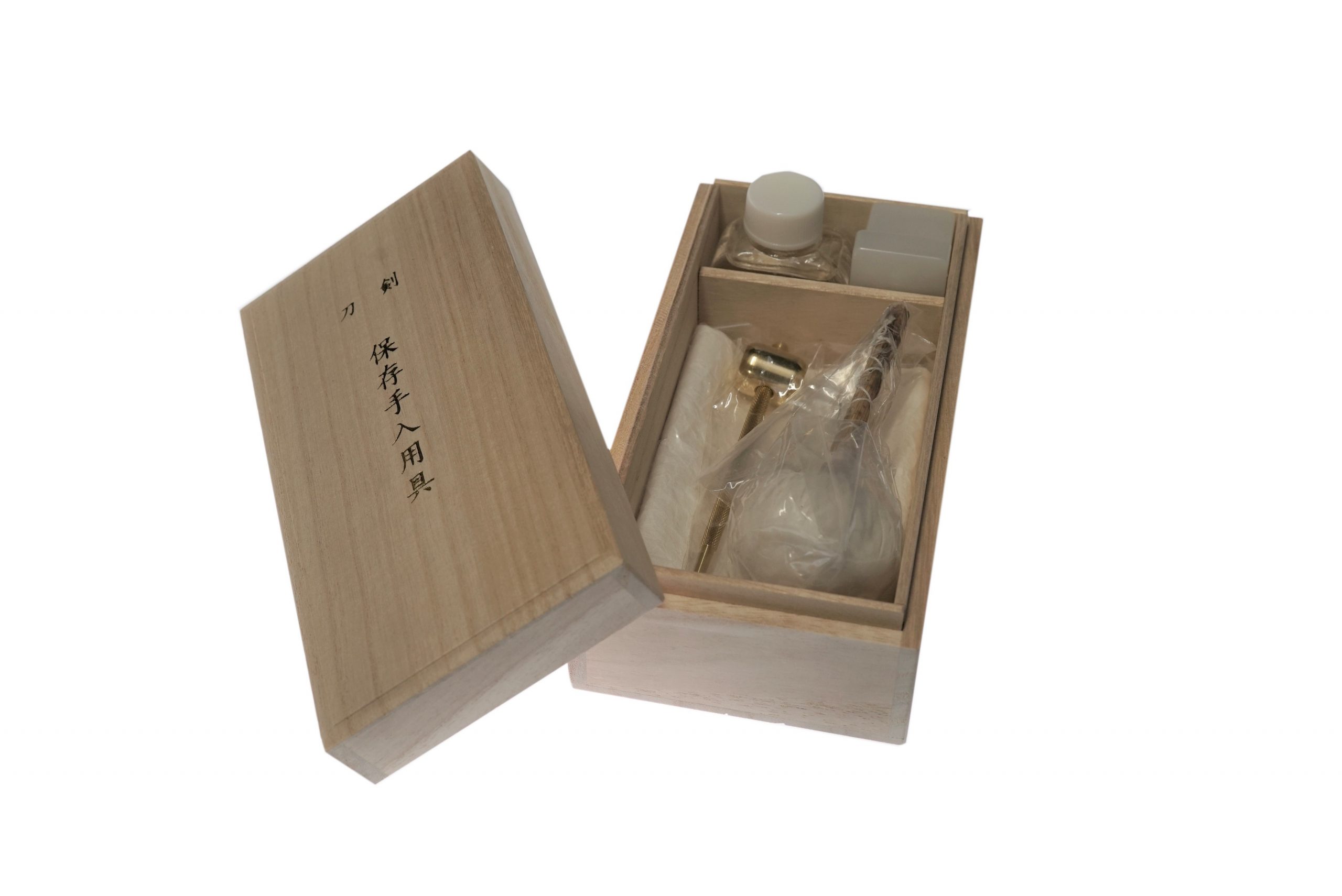
MORE ANTIQUE JAPANESE SWORD FOR SALE
SWORDS WITHOUT CERTIFICATES FOR SALE
LEARN JAPANESE SWORD TERMINOLOGY
Thank you for reading all the information on the page. If you have any difficulty choosing the right Japanese sword for you, we will be more than happy to help you find the one that speaks to you the most. Please feel free to contact us.

